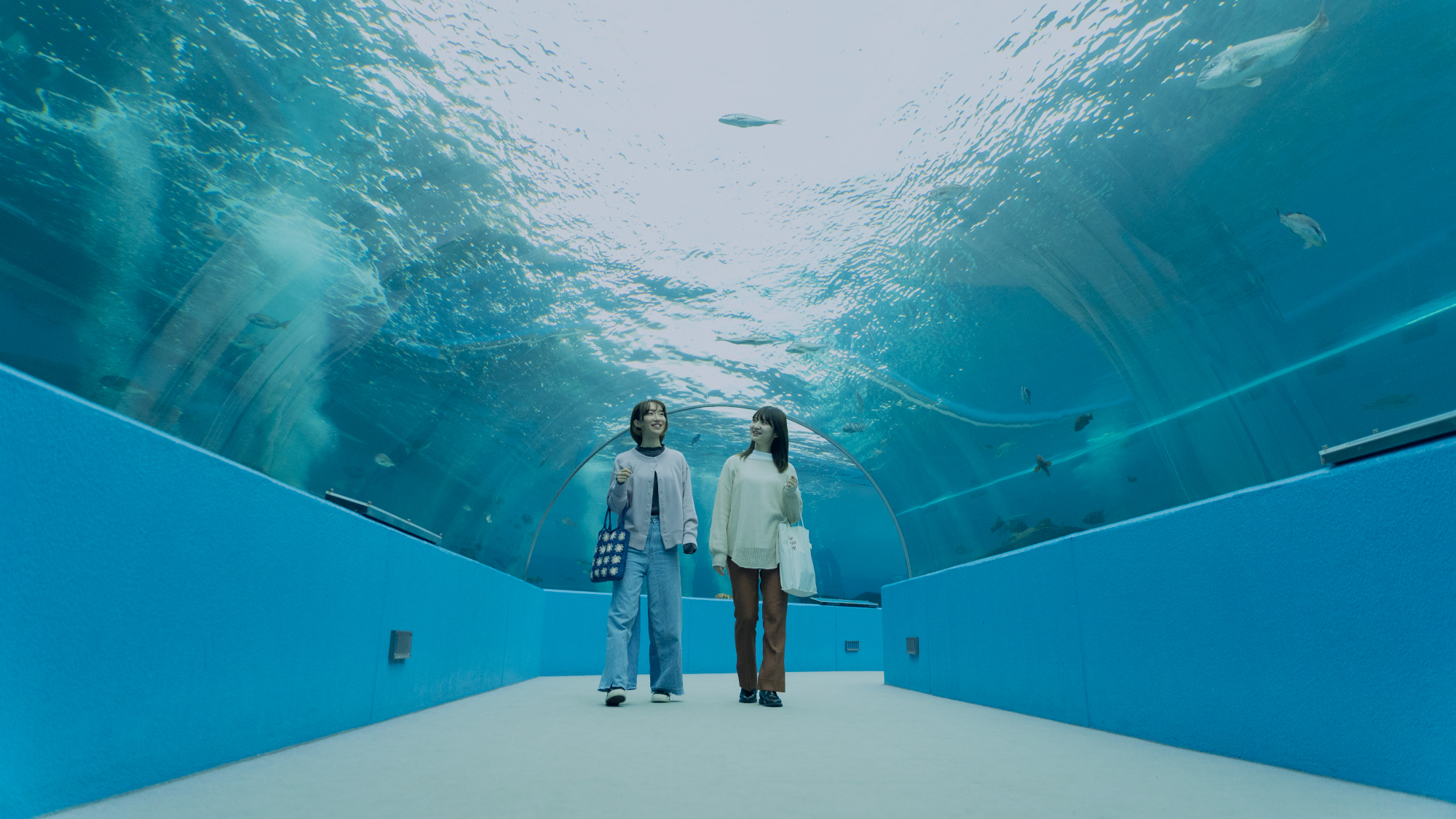Art & Culture
MUST-SEE
21st Century Museum of Contemporary Art, Kanazawa
- 7.7km
- 25mins
- From Kanazawa Port
A hub for contemporary art in Kanazawa
Designed by internationally acclaimed and award-winning Japanese architects Kazuyo Sejima and Ryue Nishizawa of architectural firm SANAA, this museum was built in 2004 to adhere to the concept of "openness". Aiming to be accessible from multiple directions, the Museum is circular with glass walls and features five gates that point towards different parts of the city. Permanent exhibits include iconic artworks such as Leandro Erlich's "Swimming Pool" and James Turrell's "Blue Planet Sky". By providing experiences of richly diverse art that transcends barriers of time and space, the Museum serves as a bridge between the region and the art of the future.
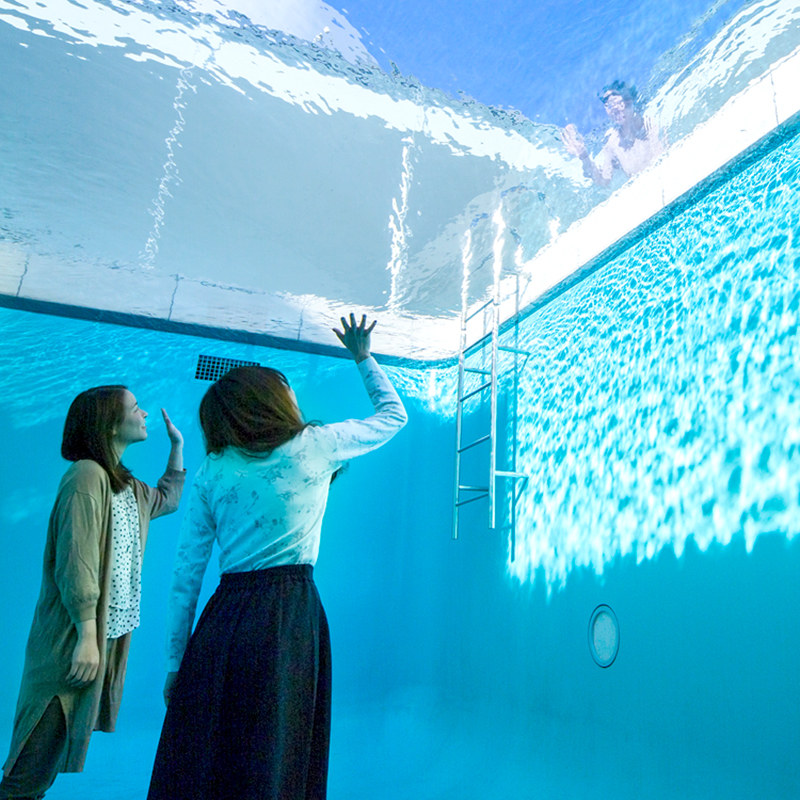
-
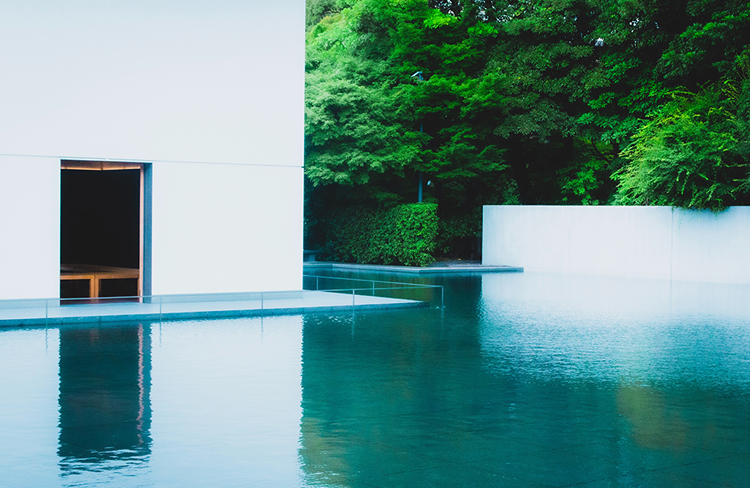
- 8.3km
- 25mins
- D.T. Suzuki Museum
-
The Museum's building uses clean, simple lines as an architectural interpretation and embodiment of prominent Buddhist philosopher Daisetz Suzuki (1870–1966) who was credited for spreading Japanese zen philosophy to the west. Designed by world-renowned architect Yoshio Taniguchi, the serene, open spaces with its three idyllic landscaped gardens, including a water mirror garden, inspire visitors to engage in thoughtful meditation as they walk through the museum's wings and gardens.
-
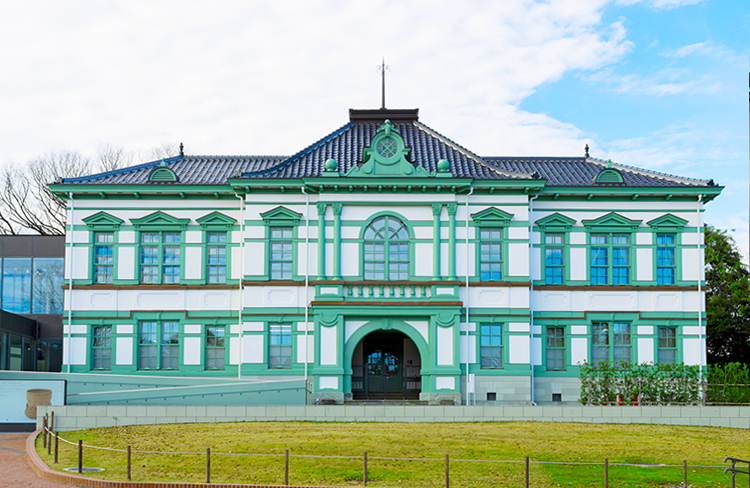
- 8km
- 25mins
- National Crafts Museum
-
In October 2020, the National Crafts Museum was relocated to Kanazawa from Tokyo, with its Western-style buildings from the Meiji Period renovated and exteriors restored to their original colors after relocation. Novices in Japanese crafts are provided lucid explanations of techniques and terminologies, including a digital-driven section with 3D images of craftworks. The museum's craft gallery houses roughly 4,000 works - from modern craft to graphic and industrial design, made in Japan and abroad from the late 19th century to the present, many of which are creations by Japan's Living National Treasures. It is the only national art museum in Japan dedicated to crafts.
-
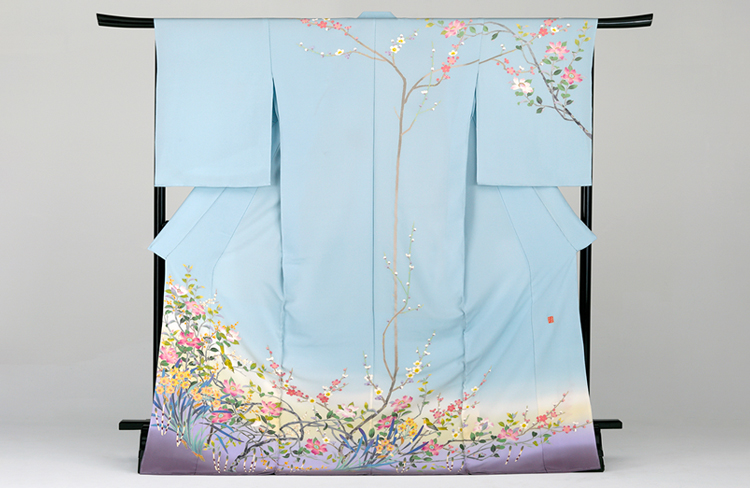
- 7.7km
- 25mins
- Kaga-yuzen Kimono Center
-
The Kaga-Yuzen Kimono Center is a small museum dedicated to Kaga-yuzen, a high-end silk dyeing technique that dates back to the 18th century. The center displays Kaga-yuzen kimono made by notable artisans and houses a Kaga-yuzen workshop where craftsmen demonstrate the dyeing process. Try on authentic Kaga-yuzen kimono or dye designs on handkerchiefs or tote bags. The special exhibition room allows for a closer view of Kaga-yuzen materials and processes.
-
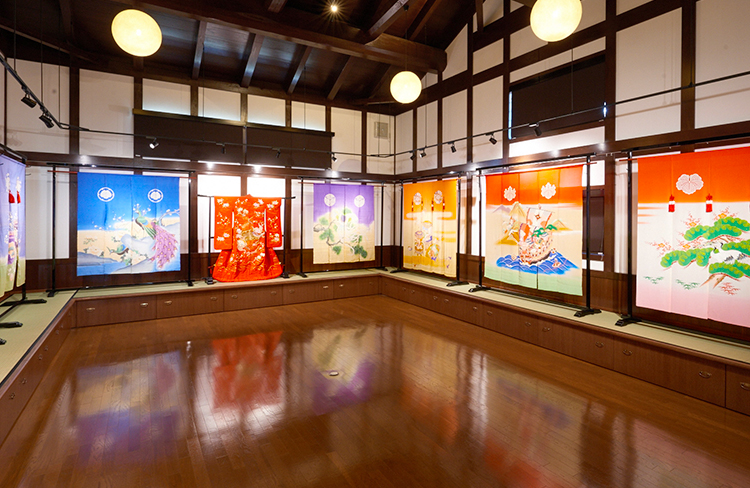
- 65km
- 70mins
- Hanayome Noren Museum
(Bridal Curtain Museum) -
Hanayome noren refers to the bridal curtain that is sent with wishes for the bride's happiness and hung at the entrance of the Buddhist altar room in the groom's house, where the bride walks through during wedding ceremonies in the Kaga Domain*2 in the 19th century. Visit the exhibition and feast your eyes on these special silk curtains dyed Kaga-yuzen style on display all year round. Experience walking through the bridal curtains after dressing up in traditional bridal kimono.
-
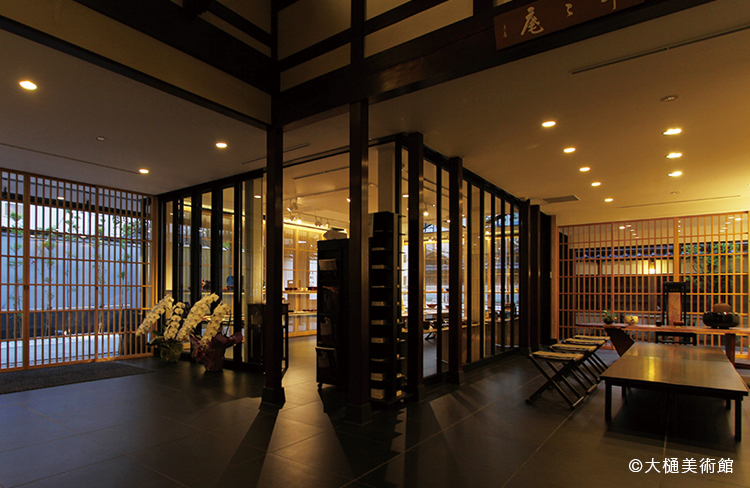
- 6.9km
- 20mins
- Ohi Museum
-
The Ohi family’s characteristically austere tea ware gained high prestige thanks to the ruling Maeda Clan's*3 patronage of the tea ceremony and art in the Edo Period (1603–1867). Although a subtle difference can be seen in the works of 11 generations of Ohi masters (named Chozaemon), their distinctive shiny amber glaze is highly regarded for their gentle feel. Nearly all works are handbuilt without using a ceramic wheel for shaping clay for more than three centuries. For a fee, visitors can enjoy matcha tea in authentic Ohi tea bowls, accompanied by Kanazawa-style sweets, in the gallery's tearoom.
-
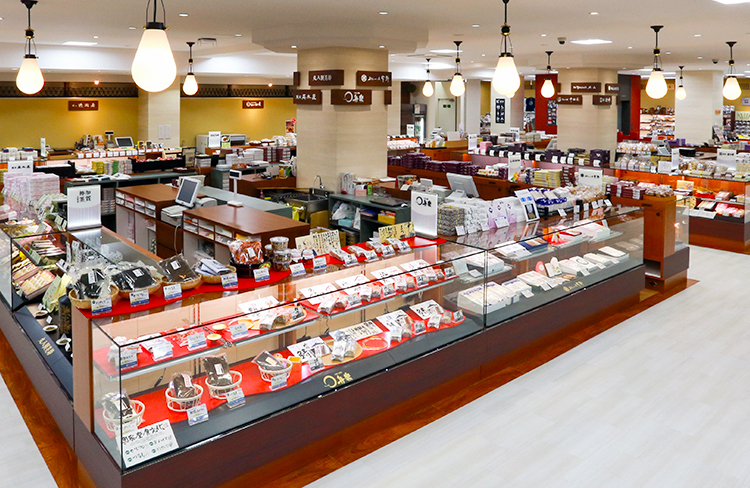
- 7.5km
- 25mins
- Ishikawa Local Products Center
-
Located right next to Kenrokuen Garden, one of Japan's three most beautiful gardens, the Ishikawa Local Products Center is a commercial facility in the heart of Kanazawa. Choose from a wide selection of Ishikawa traditional handicrafts, sweets, food, local brands of sake (rice wine) exhibited and sold by approximately 70 long-established stores, or experience making your own matcha powdered green tea, Japanese confectionery, sandblasted glass etching, or gold leaf decoration.
-
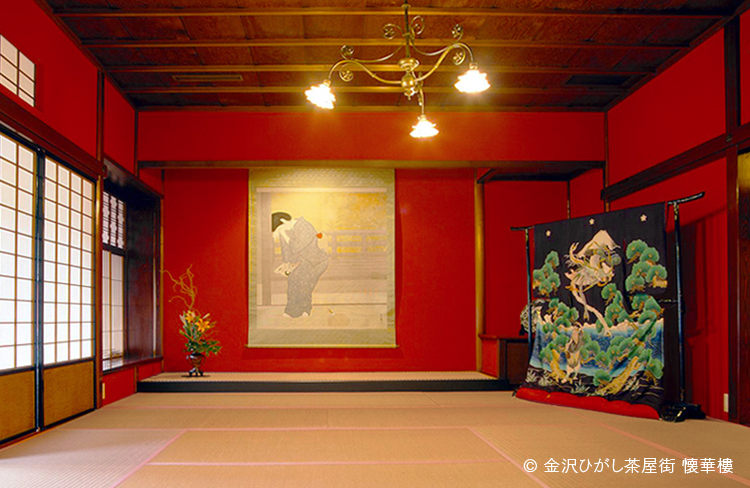
- 8.9km
- 20mins
- Kaikaro Teahouse
-
Built in 1820, Kaikaro is the biggest chaya (teahouse) in the center of the main street of Higashi Chaya District. Marvel at the exquisite interior with its wooden sliding doors, vermilion-lacquered stairs, bold paintings, and a tea room with gold-woven tatami mats. Kaikaro offers feasts and entertainment following the traditional, referral-based admittance policy in the evenings, but are open to the public during the day. Indulge in luxurious sweets while taking a glimpse at the street through the lattice windows.
-
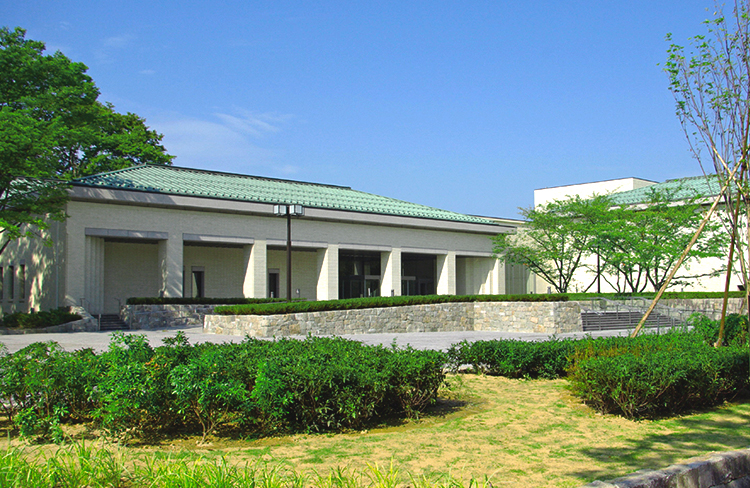
- 7.8km
- 25mins
- Ishikawa Prefectural Museum of Art
-
The Ishikawa Prefectural Museum of Art showcases the area’s tradition of fine art, which thrived under the wealthy Kaga Domain*2 during the Edo Period (1603–1867). Much of the collection used to belong to the Maeda Clan*3. The seven gallery spaces feature local ceramics, lacquer ware, Buddhist paintings, Kaga-yuzen silk kimonos, samurai swords, including a National Treasure and four Important Cultural Properties. The museum also has a café with artisanal desserts produced by a local patissier and a shop where you can find original goods along with miniature replicas.
-
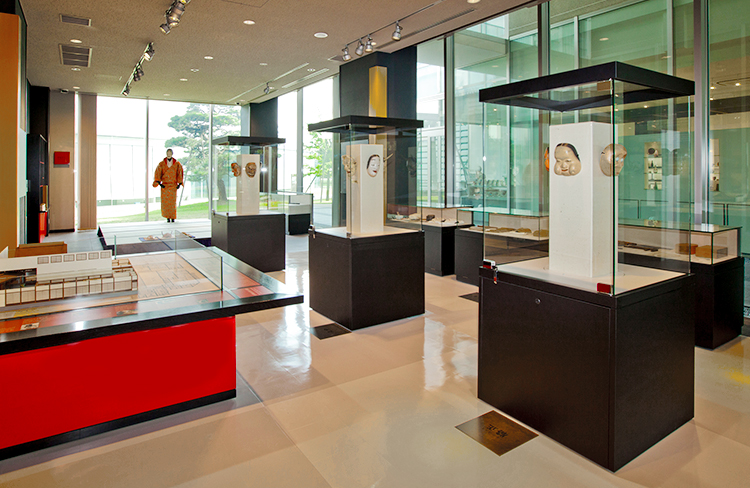
- 8km
- 25mins
- Kanazawa Noh Museum
-
Immerse yourself in the world of Noh, a 700-year-old style of Japanese theater that integrates masks, costumes, and props in a dance-based performance. Noh plays were protected as samurai entertainment by the Maeda Clan*3 and then developed as Kaga-Hosho, a performing art for ordinary people. Learn more about the history of Kanazawa through the museum's exhibitions, and enter the artistic world of Noh through a virtual Noh stage, a miniature model of the Kanazawa Noh Theater, and even try on traditional Noh costumes and masks. Noh has been designated as a World Intangible Cultural Heritage and Kaga-Hosho as an Intangible Cultural Asset.
-
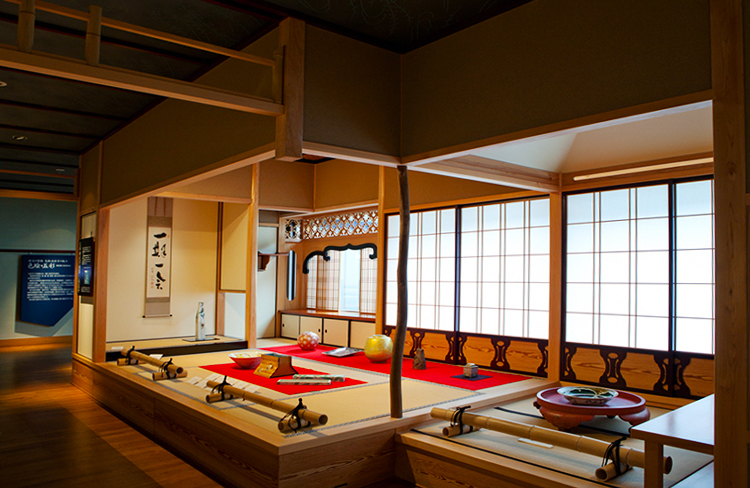
- 54km
- 50mins
- Kutaniyaki Art Museum
-
Visit the only registered museum in Japan specializing in Kutani ware, Ishikawa’s artfully decorated porcelain ware established in 1655 under the supervision of the Maeda Clan*3. Kutani ware is characterized by rich, vivid colors, elaborate designs, with overglaze brilliant enamels, and sometimes red patterns with gold ornaments. Aside from holding special exhibitions, the museum promotes Kutani pottery research by publishing catalogues and resarch bulletins. The design of the museum itself, including its tearoom, garden, and shop, incorporates Kutani tile in many places.
-
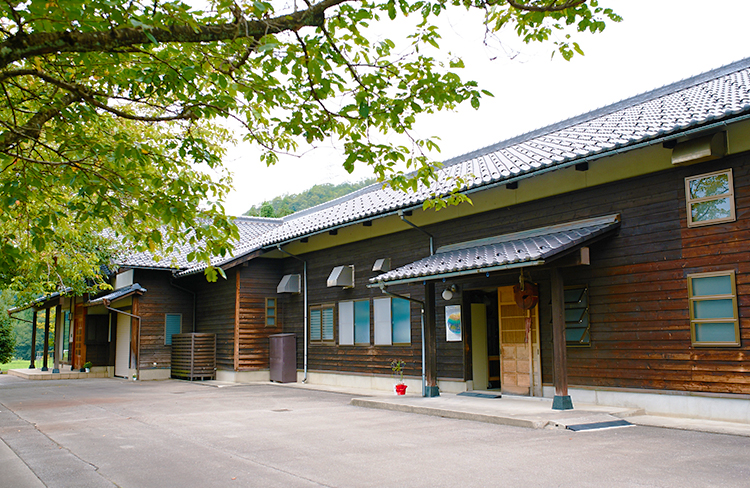
- 39km
- 50mins
- Yasokichi Tokuda Studio & Gallery
-
Famed Kutani ware craftsman Yasokichi Tokuda IV, whose father was designated a Living National Treasure in 1997, inherited her father's name and follows her father's footsteps in continuing the family potting tradition to create works with abstract designs in beautifully gradated color glazes. Yasokichi IV herself might give you a glimpse of her handicraft in a special guided tour to her renowned studio, where she creates porcelain that enriches the everyday life of people by using quality pieces of pottery.
-
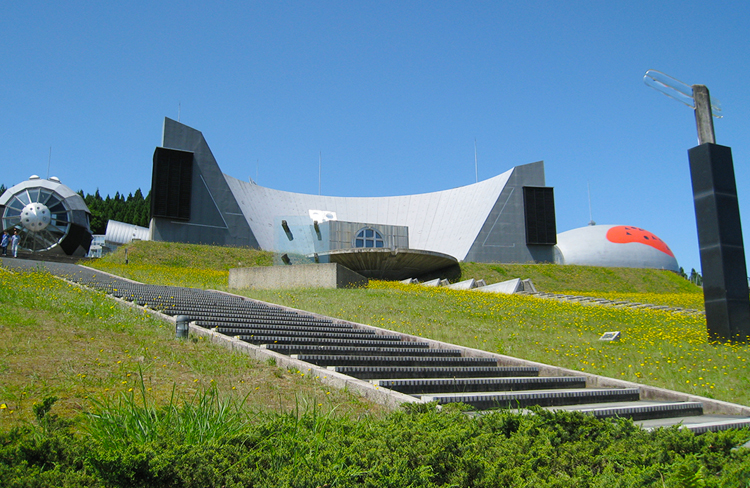
- 81km
- 75mins
- Notojima Glass Art Museum
-
Opened in 1991, this museum displays a collection of nearly 400 works of modern glass sculptures based on concepts from famous artists such as Picasso and Chagall, alongside historic Chinese and Japanese pieces. Enjoy the 13 glass sculptures outdoors as the changing seasons render them with different looks. Located on the quiet, agricultural island of Notojima, this glass art museum serves as a pioneer cultural institution specializing in glass, and also offers workshops to experience up close the philosophy of glass art-making.
-
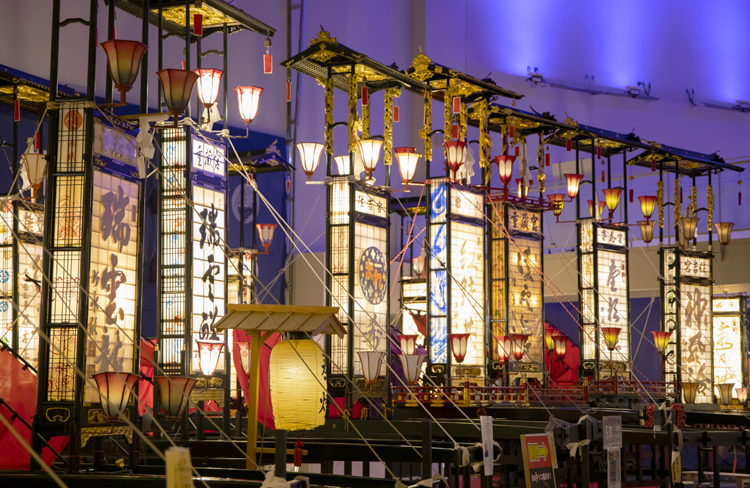
- 70km
- 60mins
- Wajima Kiriko Art Museum
-
The Wajima Kiriko Art Museum displays kiriko, towering lanterns carried in processions during summer festivals on the Noto Peninsula. The collection includes kiriko from all over Noto, including some of the largest at up to 15 meters tall. The museum recreates a festive mood with traditional music, glowing lanterns, and projections of festival footage. In the summer, there are performances of gojinjo taiko, a style of theatrical drumming native to Wajima on an outdoor stage.
Heritage & History
MUST-SEE
Kenrokuen Garden
- 8.2km
- 25mins
- From Kanazawa Port
One of Japan's three most beautiful gardens in the heart of Kanazawa
Considered one of Japan’s three most beautiful gardens and served as a private garden of the Maeda Clan*3 until 1870, Kenrokuen is a historical and cultural heritage that reflects the Kaga culture. The name Kenrokuen means “having six qualities”, representing the attributes which bring out the garden’s stunning beauty: spaciousness, tranquility, artifice, antiquity, water sources and magnificent views. It is a strolling-type garden designed with the concept of "eternal life", developed over generations of Kaga feudal lords. Kenrokuen's elegance and visual harmony earned a three-star rating from the Michelin Guide.
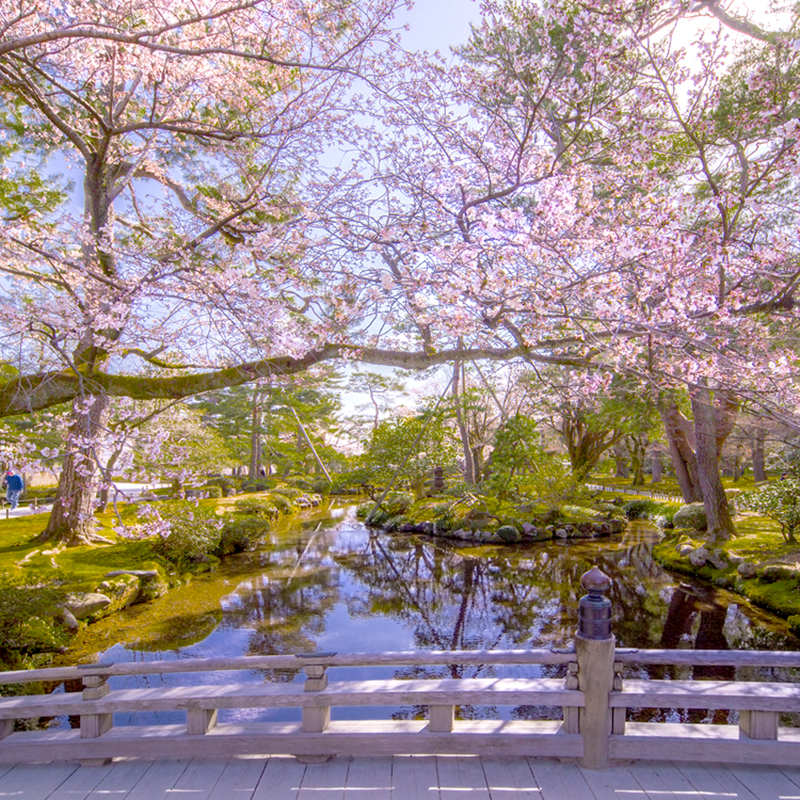
-
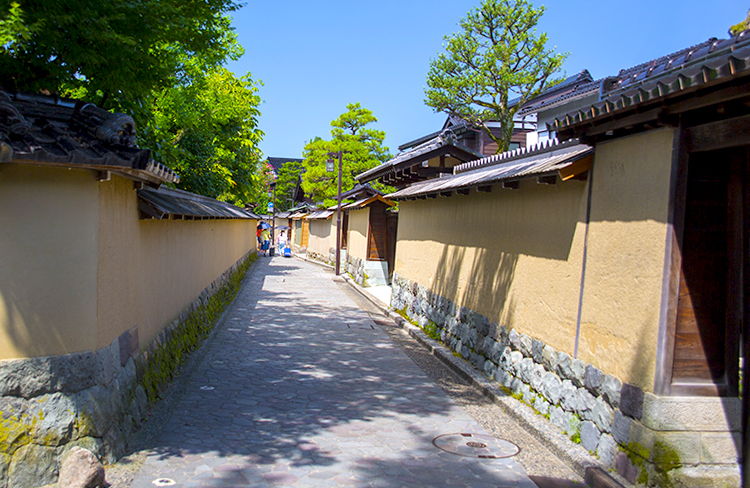
- 7.7km
- 20mins
- Nagamachi Samurai District
-
A stunningly preserved samurai district in the center of Kanazawa
The historic Nagamachi District was where the middle to high-ranking samurai once lived. It retains many features from the Edo Period (1603-1867) - narrow cobblestone streets, drainage and water supply systems, and samurai houses. Restored to their former glory, many of these samurai homes are tucked away behind thick earthen walls with distinctive clay or wooden tiles. A walk through the the picturesque streets of Nagamachi offers a peek into the samurai heritage of Kanazawa City and Japanese history.
-
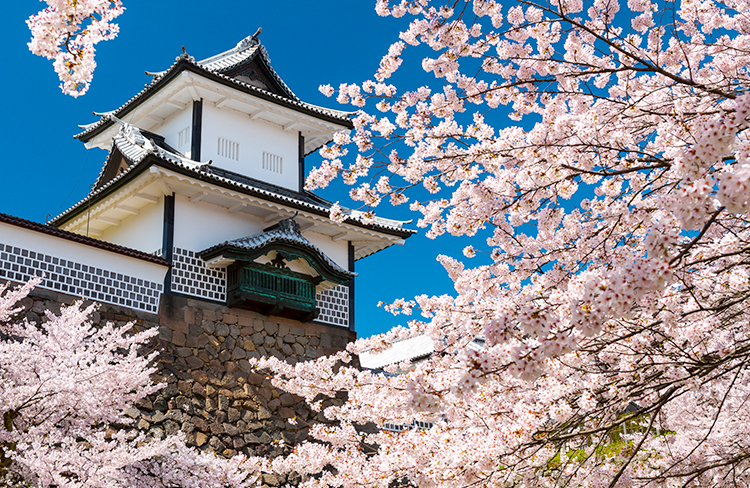
- 6.8km
- 20mins
- Kanazawa Castle
-
Faithfully rebuilt structures, large green spaces, and original stone walls
Built in 1580 under orders from Oda Nobunaga, Kanazawa Castle was home to 14 generations of the powerful Maeda Clan*3 until 1869. Despite the numerous devastating fires (the most recent in 1881) that drastically changed the structure of the castle through the expansion of enclosure, building of canals and moats, moving of mansions of vassals among others, several buildings have been faithfully reconstructed based on their design in the 1850s. Discover why Kanazawa Castle has the most variety of stone walls among all the castles in Japan as you walk through its grounds.
-
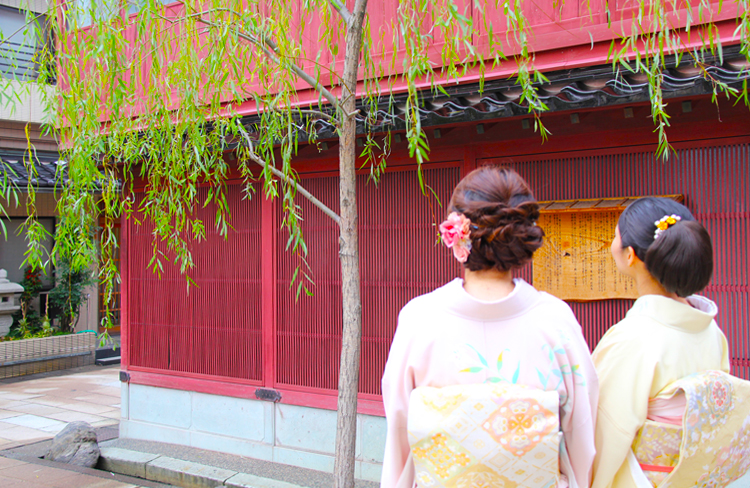
- 8.9km
- 25mins
- Higashi Chaya District
-
Designated as Japan's Important Preservation District for Groups of Historic Buildings
Established in 1820, Higashi Chaya (lit. "eastern teahouse") is the largest of Kanazawa’s three historic teahouse districts. Although many of these buildings are now used as cafés, sweets shops, and craft shops, the cobblestone streets lined with two-story wooden houses with their kimusuko lattice windows served as a place for geisha to entertain nobility and wealthy merchants with music, dance, and games. The world of geisha entertainment is exclusive and accessible only through referrals, but some of the teahouses offer tours for the general public.
-
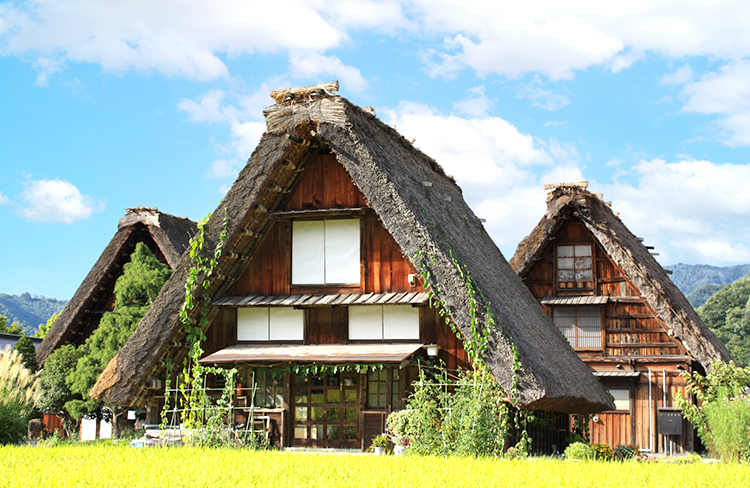
- 77km
- 75mins
- Shirakawa-go Village
-
Visit a UNESCO World Heritage Site
Located to the east of Kanazawa City, in the northwestern part of Gifu Prefecture, is a small traditional village called Shirakawa-go. It is a UNESCO World Heritage Site, nestled in bountiful nature of the mountainous areas and lush beech forests at the feet of the sacred Mt Hakusan.The village's oldest remaining 26 gassho-style farmhouses with their steeply pitched thatched roofs date back to more than 350 years. Explore the southern part for skin-beautifying hot springs, milky-white waterfalls, an emerald-green lake, among others.
-
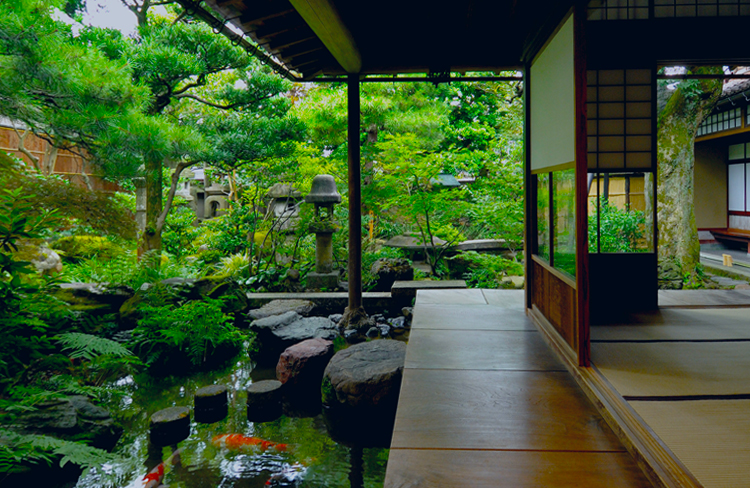
- 7km
- 20mins
- Nomura Samurai Residence
-
Inside an authentic samurai house
The Nomura Residence in Nagamachi Samurai District is the former estate of 11 generations of an upper-middle-rank samurai family responsible for horseback security for the lords of the Kaga Domain*2. Its garden features a stream, waterfall, granite bridge, and a 400-year-old bayberry tree. It was chosen as the third-best Japanese garden in 2003 by the Journal of Japanese Gardening and awarded two stars by the Michelin Green Guide in 2009. Admire the garden from the upstairs tea room while drinking matcha tea.
-
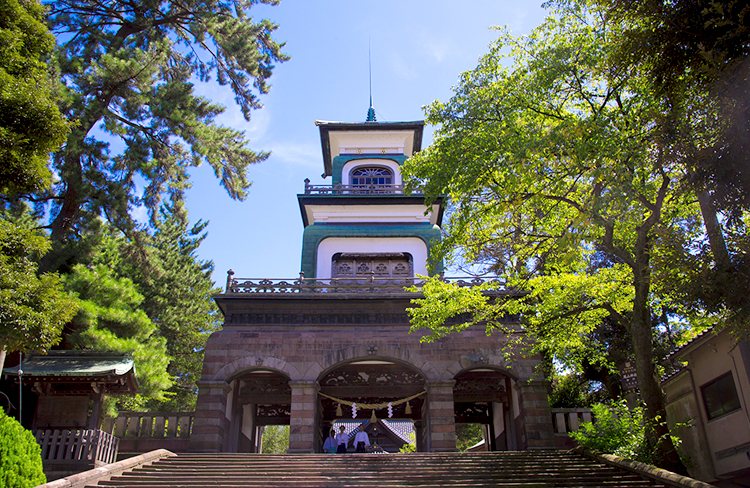
- 6.9km
- 20mins
- Oyama Jinja Shrine
-
A shrine designated as an Important Cultural Property
Oyama Jinja is a Shinto shrine dedicated to the founder of the Kaga Domain*2, Maeda Toshiie (1537–1599) and his wife, Matsu (1547–1617). It was built in 1873, shortly after the abolition of laws that prevented shrines from being dedicated to people other than the shogun. The shrine's three-storied 25 meter-high gate, with its unique blend of Japanese and Chinese architectural style with Western touches in the stained glass windows, was built in 1875 and is designated as an Important Cultural Property.
-
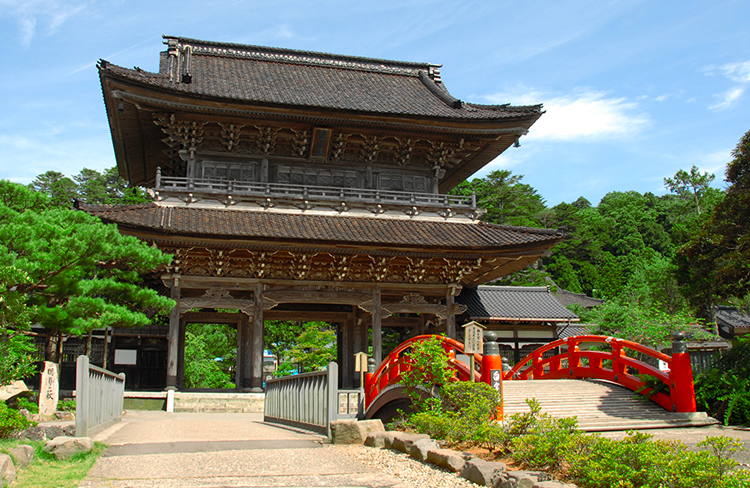
- 103km
- 90mins
- Sojiji Soin Monastery
-
Visit or stay in a Zen Buddhist monastery
Zen master Keizan (1268-1325), credited with spreading the Soto school of Zen Buddhism in Japan, founded Sojiji in 1321, which quickly became one of the two head temples of the school. Step into Dharma Hall, a wooden building adorned with gold, Wajima lacquer and intricate carvings, or experience their guided Soto Zen meditation sessions, or spend a night in the monastery and try some vegetarian Buddhist cuisines. You may even meet the temple's English-speaking monk from Germany if you participate in the morning prayers.
-
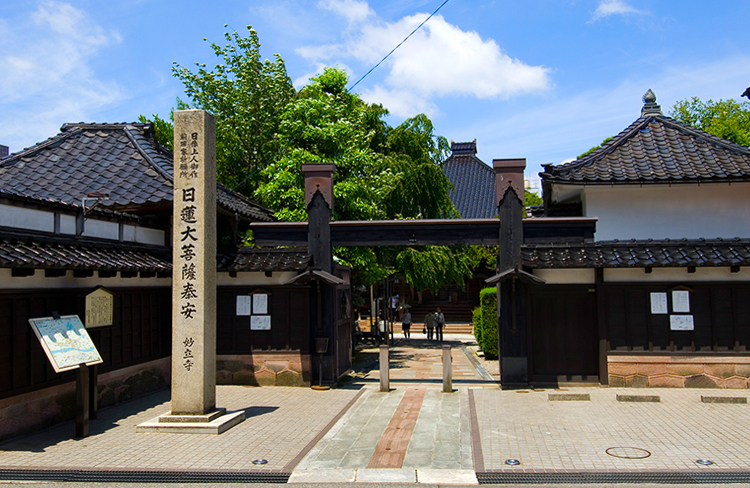
- 8.4km
- 25mins
- Myoryuji Temple (Ninja Temple)
-
A labyrinth of corridors and trapdoors in the temple
Originally built in 1643 when the prayer hall in the castle was relocated, Myoryuji Temple served as a disguised fort amidst tension caused by Tokugawa Shogunate's constant surveillance of the Kaga Domain*2. The temple earned the nickname "Ninja Temple" for its numerous hidden rooms, secret passageways, and maze-like stairwells. Explore the numerous trapdoors, or climb up to the roof to get a distant view of Kanazawa Castle which, according to legend, is connected to the temple's well through a secret tunnel.
-
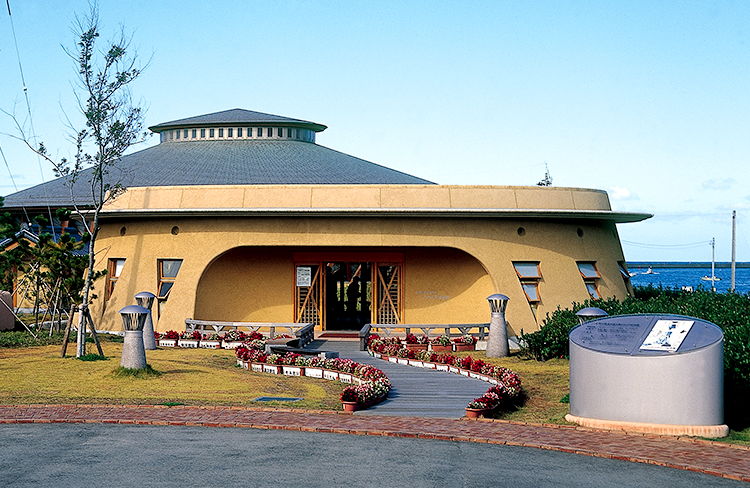
- 2.2km
- 25mins
- Karakuri Memorial Museum
-
Karakuri mechanical dolls - Japan's ancient robots
Karakuri is a traditional Japanese wind-up mechanical doll or puppet built and popularized in the Edo Period during the 17th century, with expressive faces and fluid movements rendering them a life-like appearance that inspire emotional affinity. The museum commemorates the great achievements of Benkichi Ohno, a famous karakuri craftsman who settled down in the area from 1831. Have a go at wooden mosaic puzzles, or watch tea-serving wooden puppets during a demonstration and see for yourself how karakuri is no doubt a prototype of our modern robots.
-
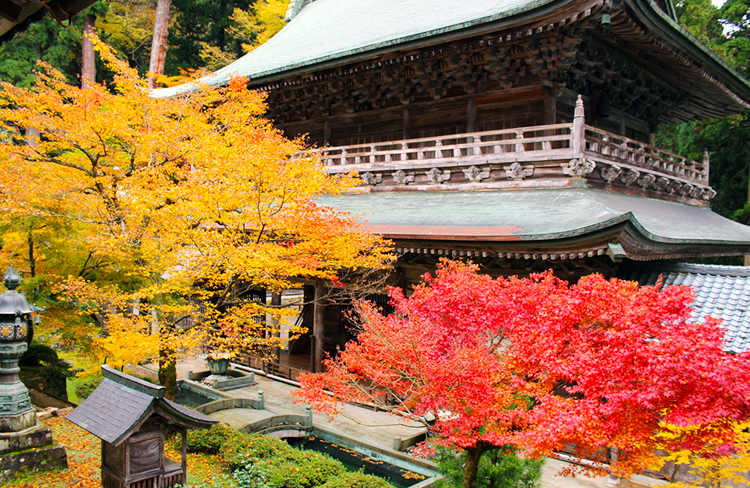
- 84km
- 75mins
- Eiheiji Temple
-
The "Premier Training Hall" in Soto Zen Buddhism
More than an actual temple, Eiheiji is a temple school that trains monks from all over Japan-and it's where Apple co-founder Steve Jobs considered learning zazen meditation. Founded by Zen Master Dōgen in 1244, Eiheiji (Temple of Eternal Peace) is one of the two head temples of Soto Zen Buddhism along with the Sojiji Soin Monastery. Located deep in the mountains not far from Fukui City, the buildings in the 330,000sq.m. temple grounds are connected with roofed corridors. Over a hundred monks engage in the rigorous training of shikantaza (practice of "just sitting").
-
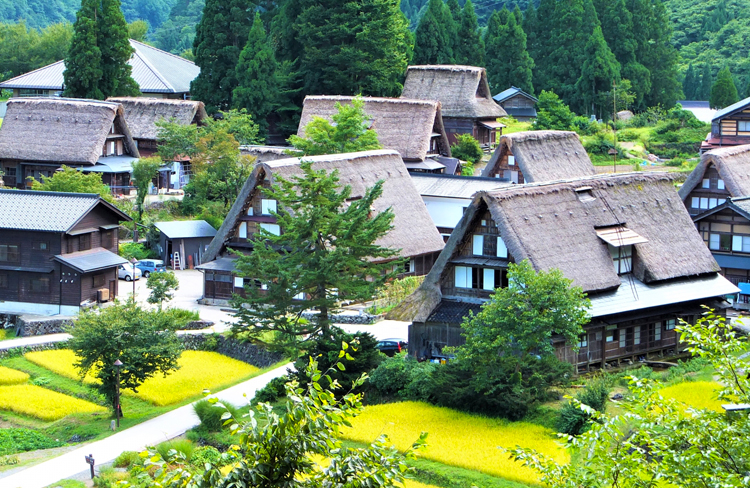
- 64km
- 75mins
- Gokayama
-
A traditional way of life adapted to the environment
Situated within Nanto City in Toyama Prefecture, surrounded by plenty of enchanting natural scenery, the Gokayama area is recognized as a UNESCO World Heritage Site because of its historic villages. Aside from a number of traditional gassho-style houses with thatched roofs – the oldest of which date as far back as 400 years, the villages also feature lodgings, museums, souvenir shops, and religious buildings, with the Shogawa and Oyabegawa rivers running through Nanto City and the forests of Hakusan National Park located nearby.
-
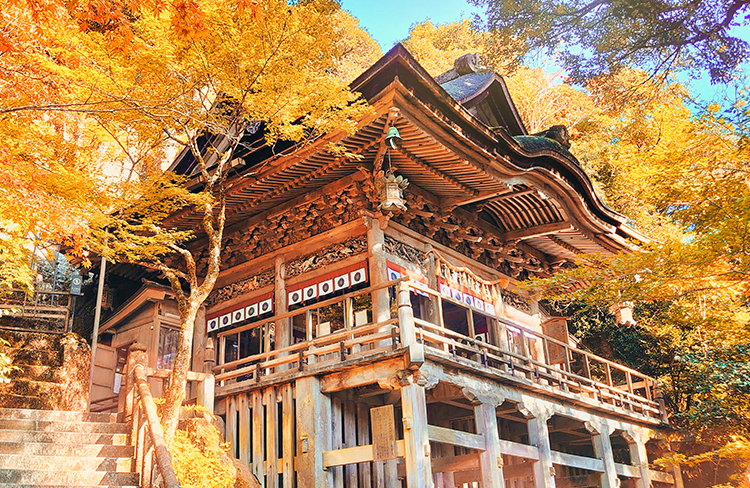
- 45km
- 50mins
- Natadera Temple
-
A treasure trove of Important Cultural Properties
Since ancient times, the natural rock formations at Natadera Temple in Mt. Hakusan*1 have been revered as a sacred place of birth, death, and reincarnation. Natadera Temple was built directly into these caves in 717 by the great monk Taicho. In 1640, Maeda Toshitsune (1594-1658) reconstructed the temple after three wars. Seven of its buildings have been designated as important cultural properties, and its scenic grounds of mossy forests, traditional-style gardens, and carp-filled ponds earned Natadera a star in the Michelin Green Guide in 2015.
-
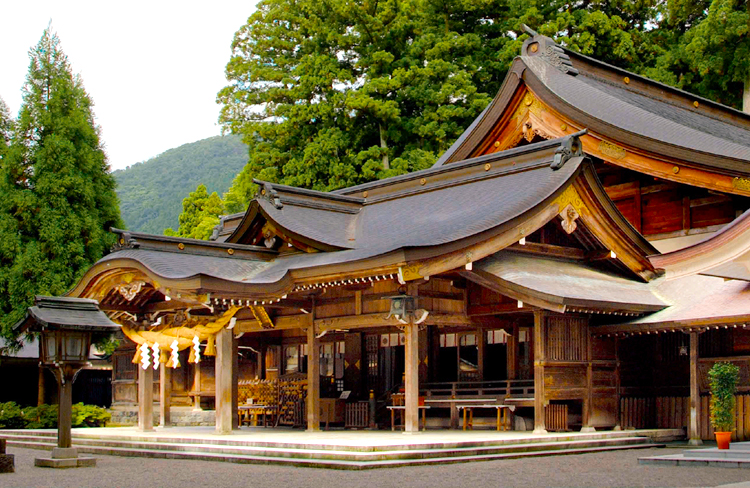
- 23km
- 40mins
- Shirayama Hime Jinja Shrine
-
The Head Shrine of roughly 3,000 shrines dedicated to Mt. Hakusan
Shirayama Hime Jinja is a 2,100-year-old shrine dedicated to the sacred Mt. Hakusan*1. Its tree-covered grounds include an 800-year-old cedar and a trio of cedars planted by Emperor Showa (1901–1989). Zelkova, maple, and cedar trees line the 250-meter path leading up to the shrine and the clear stream running along the path helps purify the mind. The enshrined dieties include Kukuri-Hime-no-Kami, revered as both the goddess of matchmaking and goddess of marital conjugal bliss. Swing by the shrine museum to have a glimpse of the substantial collection of valuable treasures related to the Hakusan faith.
Hands-on Experiences
Japanese Confectionery-Making Experience
- 7.5km
- 25mins
- From Kanazawa Port
Through the efforts of the Maeda Clan*3 in promoting the way of tea (sado), Japanese traditional sweets have also become an integral part of tea ceremonies. They're made in a variety of shapes and consistencies, with diverse ingredients and preparation methods. Today, Kanazawa's consumption of sweets is the largest in Japan. Take a course in making these delicious, fresh treats in several locations throughout Kanazawa.
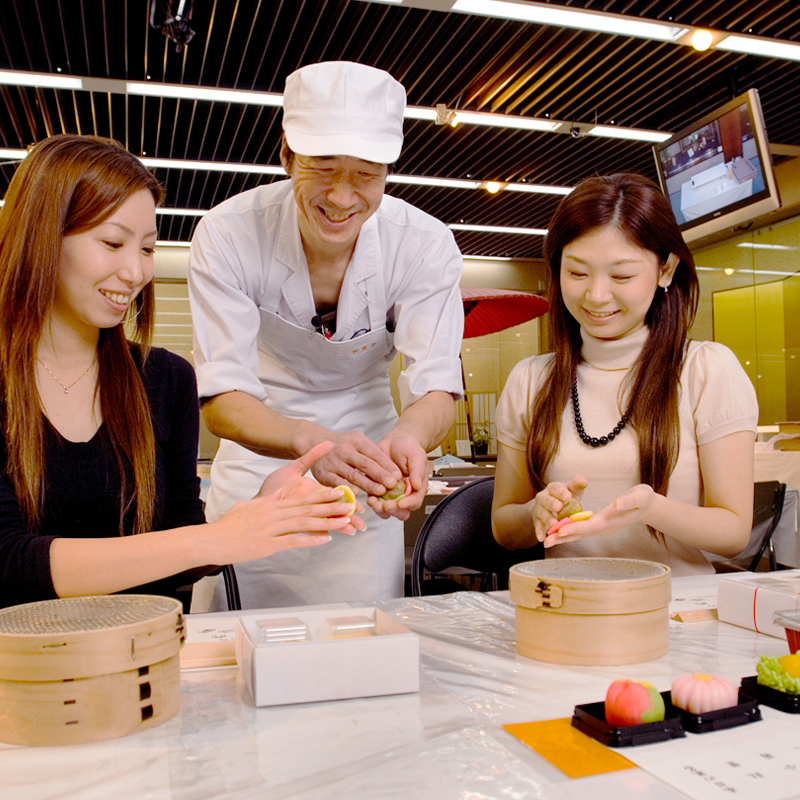
-
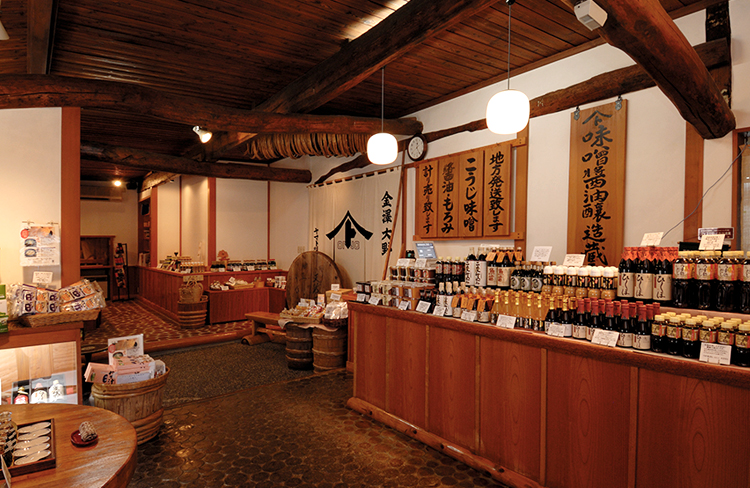
- 1.4km
- 15mins
- Soy Sauce & Miso-Tasting
-
Visit brewers of authentic Japanese soy sauce or fermented soy bean paste (miso), and discover why Japanese maltsters and brewers have beautiful skin. Learn about their histories in a guided tour of their warehouse, or teach your palate the difference between young and aged miso. Try different products such as snacks, rice wine, pudding, or ice cream and open your taste buds to a wide array of rich aromas and mellow flavors. You can also pick up some freeze-dried soy sauce or salad dressings in various bottle sizes to bring home from Kanazawa.
-
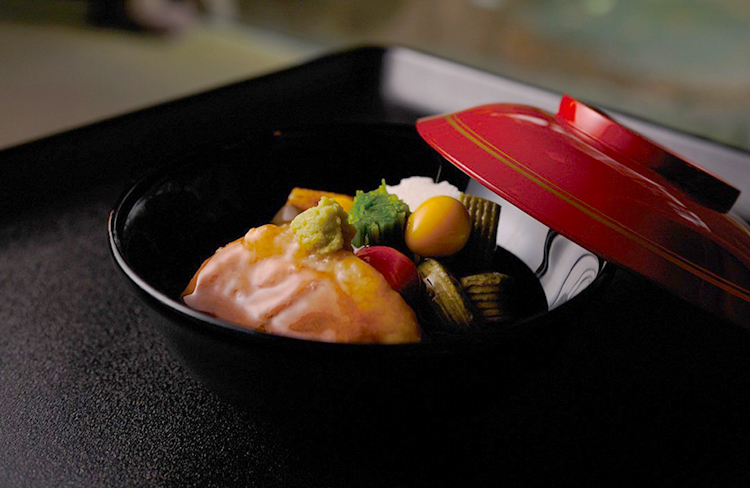
- Depends on location
- Kaga Cuisine Cooking
-
Kaga-ryori (Kaga cuisine) is characterized by the combination of rich ingredients from the mountains and the Sea of Japan, served in gorgeous Kaga Maki-e laquerware and Kutani porcelain. Under the guidance of professional chefs, try your hand at making popular Kaga cuisines such as jibu-ni, a traditional Ishikawa duck meat stew with vegetables simmered in kelp and bonito stock.
-
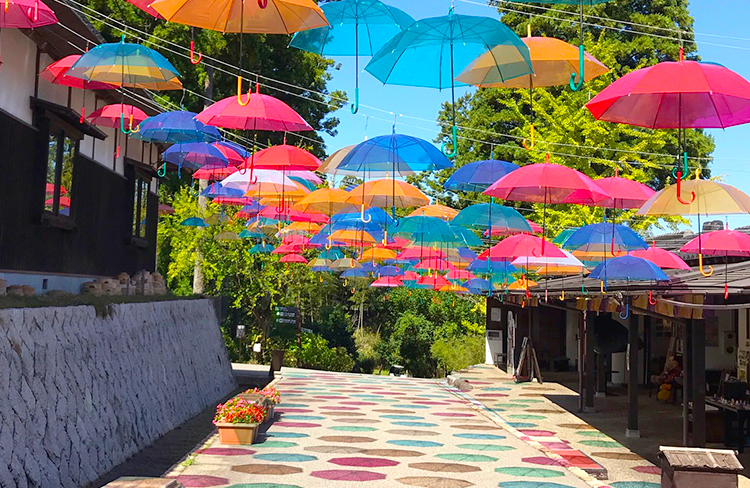
- 43km
- 50mins
- Yunokuni no Mori
-
A theme park village of Japanese handicrafts
The theme park consists of traditional-style houses spread out over a wide swath of forest. Masters of their respective craft await you in each house, teaching and helping visitors to make their own crafts. Visitors can design Wajima lacquer ware, adorn tableware with gold leaf, paint Kutani pottery, or even make their own Japanese paper. The houses also display works made by local artisans.
-
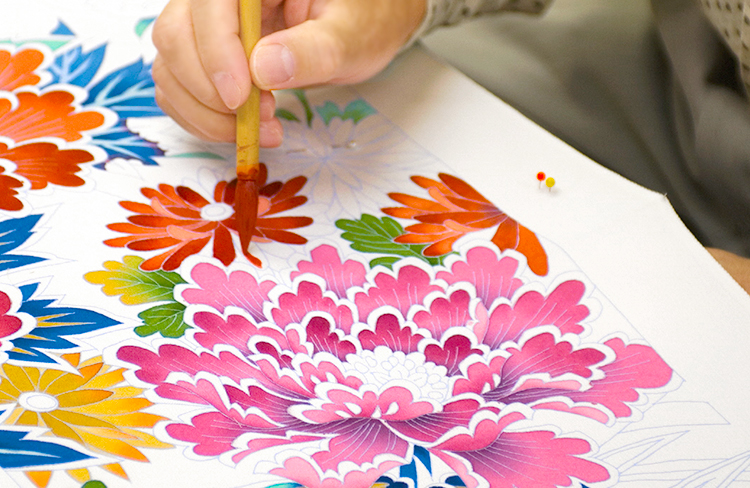
- 7.7km
- 25mins
- Kaga-yuzen Experience
-
Over 300 years of dyeing technique in Ishikawa
Kaga-yuzen is a silk-dyeing technique characterized by its use of five basic colors (indigo, crimson, ocher, dark green, royal purple) called Kaga-gosai, applied to intricate designs such as flowers, birds, and landscapes. This style of dyeing is used mainly for high-end kimono and has flourished under the patronage of the Maeda Clan*3. Various studios in Ishikawa offer hands-on experiences ranging from wearing Kaga-yuzen kimono and yukata, and in recent years, to dyeing items such as handkerchiefs or tote bags.
-
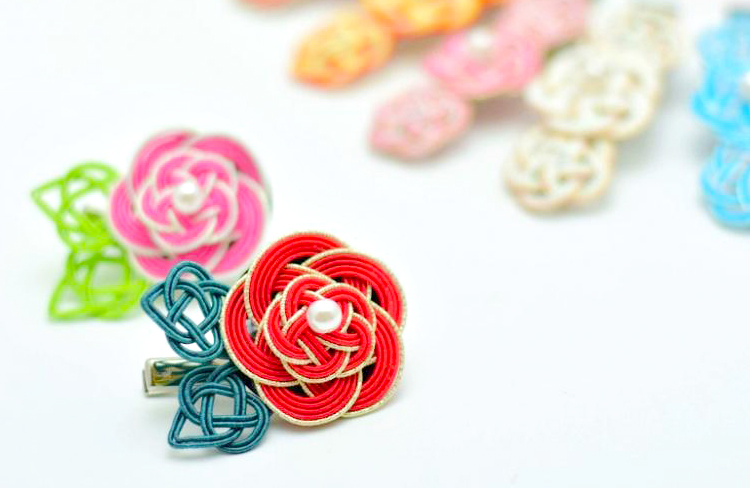
- 7km
- 20mins
- Mizuhiki Tying & Threading
-
Mizuhiki (string craft) is the art of skillfully knitting paper thread to adorn presents and ceremonial envelopes, an indispensible part of Japan's gift-giving culture. Around 1915, Kaga Mizuhiki founder Sokichi Tsuda I came up with the original idea of turning flat mizuhiki into gorgeous 3D handiwork with realistic depictions of cranes and turtles, grouping them with other materials such as pine, bamboo, and plum trees. Create your own decorative envelope for a special occasion, or make accessories such as earrings or necklaces.
-
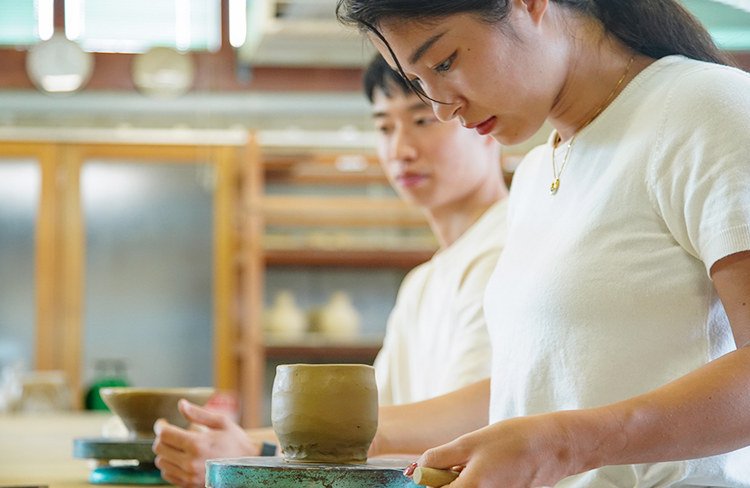
- 140km
- 130mins
- Suzu Ware Experience
-
Suzu ware was produced in Suzu City (Noto Peninsula) from the late 12th century to the end of 15th century, one of the potteries representative of medieval Japan that has been found in many locations along the coast of the Sea of Japan. Suzu ware is fired with a smoke firing technique, resulting in its distinct shade of dark gray. Using a manual potter's wheel to shape the clay, create your own Suzu jar, pot, or bowl.
-
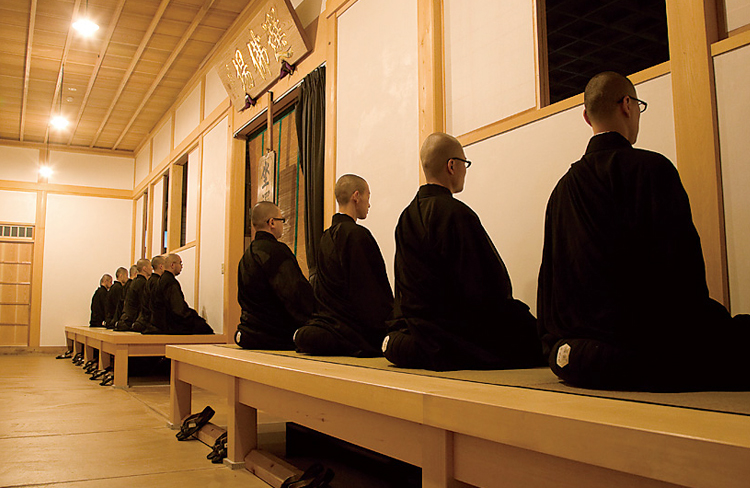
- Depends on location
- Zazen Meditation
-
In the 13th century, Japanese monk Dōgen brought Soto Zen to Japan after a stay in China. Zazen (lit. seated meditation) is considered the heart of Japanese Soto Zen Buddhist practice, where meditation is done in a seated position, with half-opened eyes, practicing mental concentration. Visitors can experience zazen at a few temples around Ishikawa, where they can even join trainee monks in their actual meditation room. Some temples offer overnight stays called shukubo, which pair meditation with a taste of daily temple life and traditional Buddhist vegetarian meals.
-
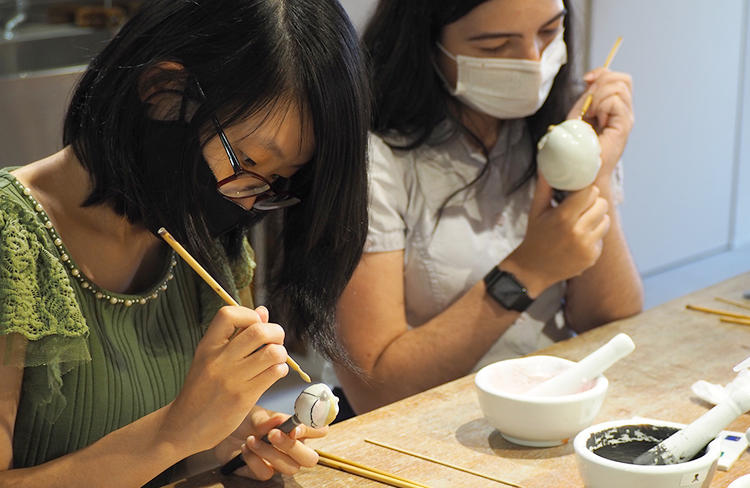
- 8.4km
- 25mins
- Kutani Porcelain Experience
-
Kutani pottery is a vividly colored style of porcelain local to Ishikawa Prefecture. At various locations in Ishikawa, visitors can observe the entire process of ceramic production -- from molding to overglaze painting. Under the guidance of craftsmen, try wheel-throwing and feel the fine porcelain clay as you knead, or try painting a design on a white vessel. Either way, you will be awed at the finished Kutani ware shipped to you.
-
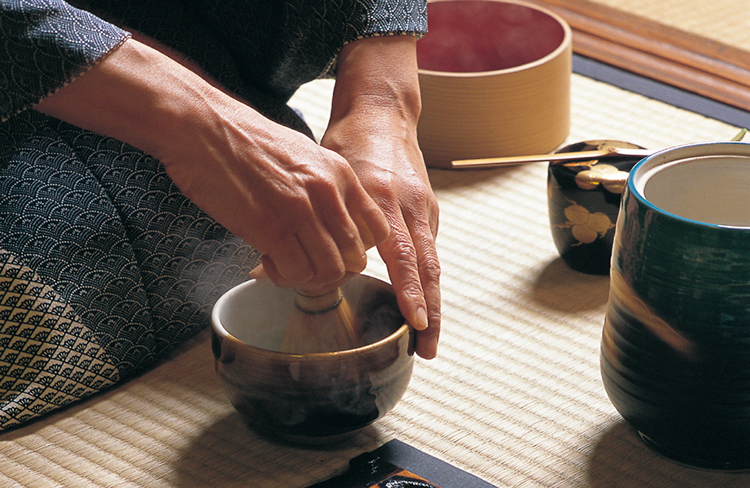
- 7.5km
- 25mins
- Tea Ceremony
-
The tea ceremony (sado) is integral to the history and culture of Ishikawa. The Maeda Clan*3 were particularly fond of the art and encouraged it to flourish. They invited top tea masters to Kanazawa to further the practice and development of the tea ceremony. Some experts do believe that the samurai studied tea ceremony because its rules and rituals mirrored combat. Today, matcha, or powdered green tea, can be enjoyed at a number of traditional-style tea rooms within Ishikawa.
-
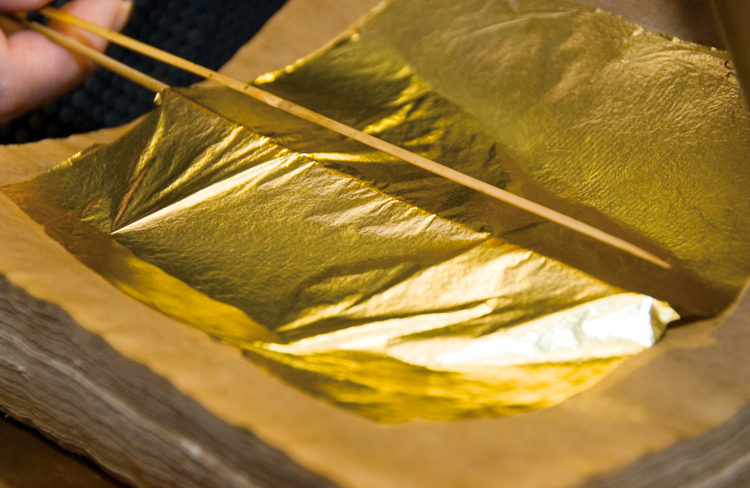
- 7.5km
- 25mins
- Gold Leaf Crafts
-
Hammered into extremely thin sheets of gold used decoratively on handicrafts or ornaments, the gold leaf is one of the symbols of craftsmanship of Ishikawa. It is believed that the production of gold leaf in Kanazawa began around 430 years ago. Aside from the highly-skilled gold leaf artisans, Kanazawa's climate of frequent rain and snow had contributed to the superb quality of Kanazawa's gold leaf. Today, Kanazawa City holds 99% of Japan’s domestic gold leaf market. Several shops around Kanazawa let visitors see the gold leaf process and decorate their own items, including chopsticks, small plates, and mirrors.
-
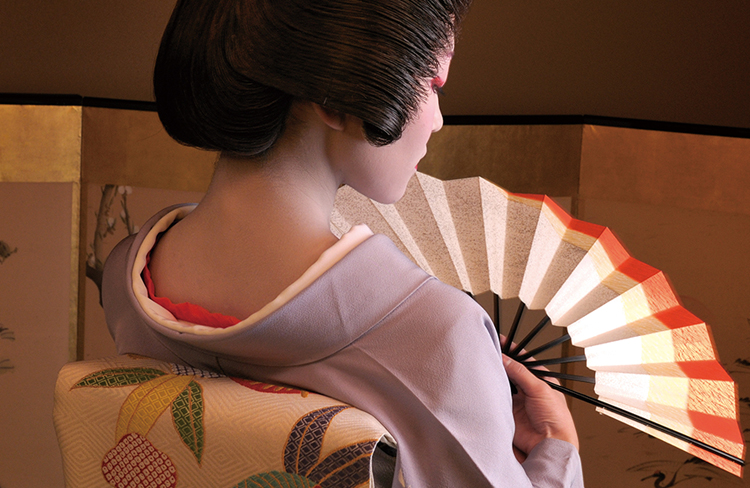
- 9km
- 25mins
- Geisha (Geigi) Entertainment
-
Kanazawa is second only to Kyoto for the number of active geisha, so seize the opportunity to enjoy an evening with geisha at some establishments in the historic teahouse (amusement) districts in the city. Listen to the proprietors as they tell you about teahouses, the geisha who entertain there, and a typical day in their lives. You may even have a chance to play along with the geisha's music and games, a rare opportunity even among the Japanese.
Cuisine
MUST-SEE
Omicho Market
- 6.5km
- 20mins
- From Kanazawa Port
Discover "Kanazawa’s Kitchen"
Established during the Edo Period, Omicho Market has formed an essential part of Kanazawa’s food culture for 300 years. A wide array of gastronomic delights await you as this sprawling market features more than 170 stores, with a large number of fishmongers selling freshly caught seafood from the Sea of Japan, including crab and yellowtail. Fruit and vegetables stores selling unique local produce, marine product stores, clothing stores, grocery stores and restaurants line the market streets.
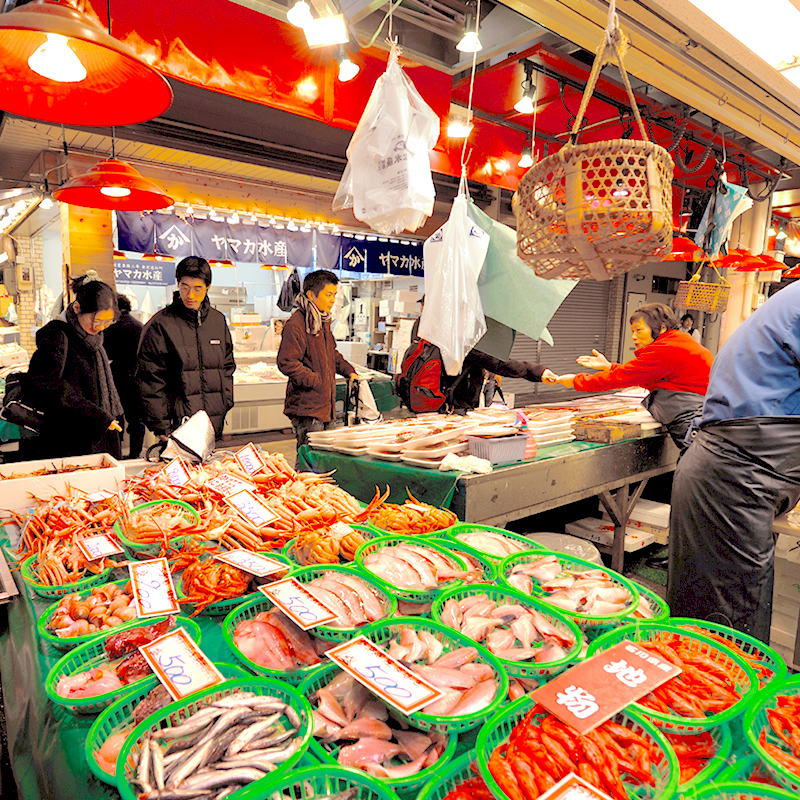
-
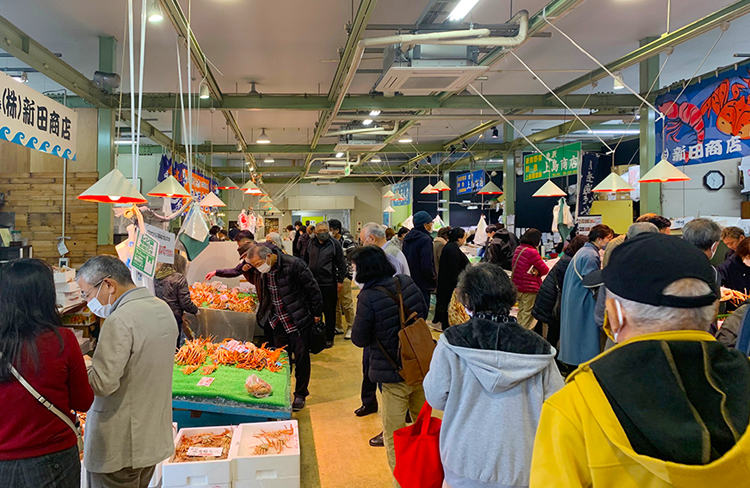
- 750m
- 15mins
- Kanazawa Port Iki-iki Fish Market
-
At Kanazawa Port Iki-iki Fish Market, affordable fresh marine products including zuwaigani (snow crab) and ama-ebi (sweet shrimp) can be purchased directly from fishermen and local dealers without the intermediary cost because it is located right next to the port. You can also have the purchased fish cut into sashimi to enjoy right there at the market. Savor the authentic local seafood sourced from Kanazawa in Ishikawa Prefecture, blessed with one of the richest fishing grounds in the Sea of Japan.
-
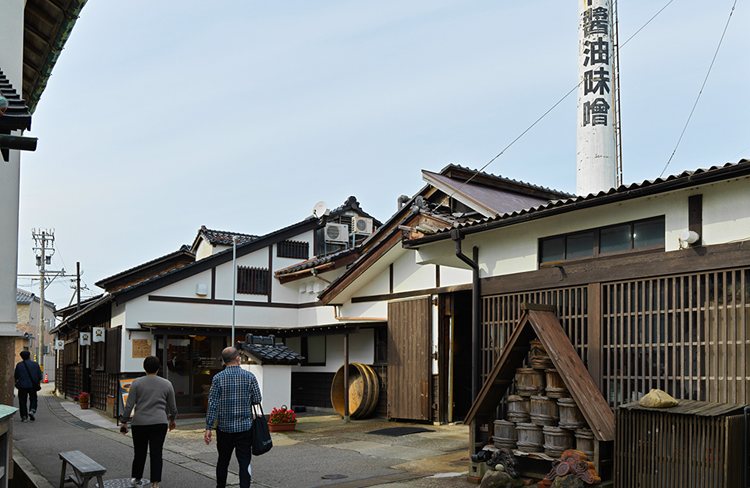
- 1.4km
- 15mins
- Soy Sauce & Miso
(Kanaiwa and Ohno Areas) -
A route connecting Osaka and Hokkaido via the Sea of Japan was active from the latter half of the 18th century to the beginning of the 20th century. The Kanaiwa and Ohno areas prospered as a port town on the route to Kanazawa. In the Ohno area, in particular, soy sauce has been manufactured from salt and soybeans carried by ship and subsoil water taken from the area, supporting the taste of Kaga cuisine throughout the years. Even now, people can see a row of soy sauce storehouses unique to this area.
-
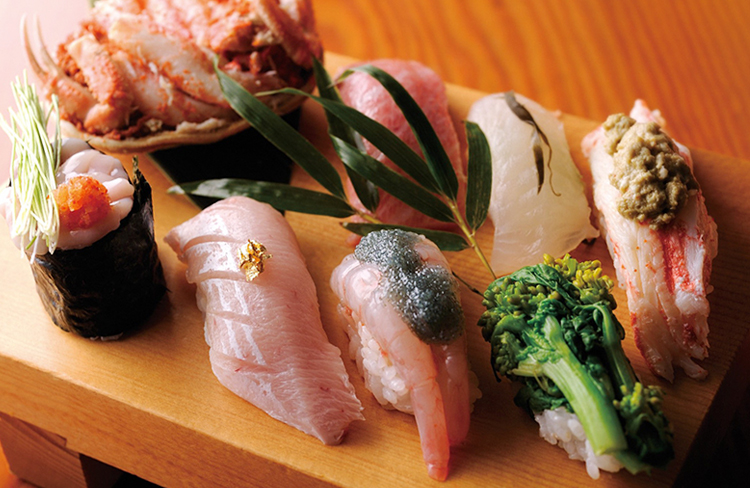
- Depends on location
- Sushi
-
Sushi in Ishikawa highlights fresh, local fish from the Sea of Japan. Seafood is a reflection of the seasons, and sushi is a great way to try the day’s best catch. Thanks to the fresh supply of fish and shellfish, there are many sushi restaurants and conveyor belt sushi bars in Kanazawa. The delicacy of Ishikawa's sushi has obtained national recognition for its high quality and delectable taste, all the more made popular by the prefecture's unparalleled chefs.
-
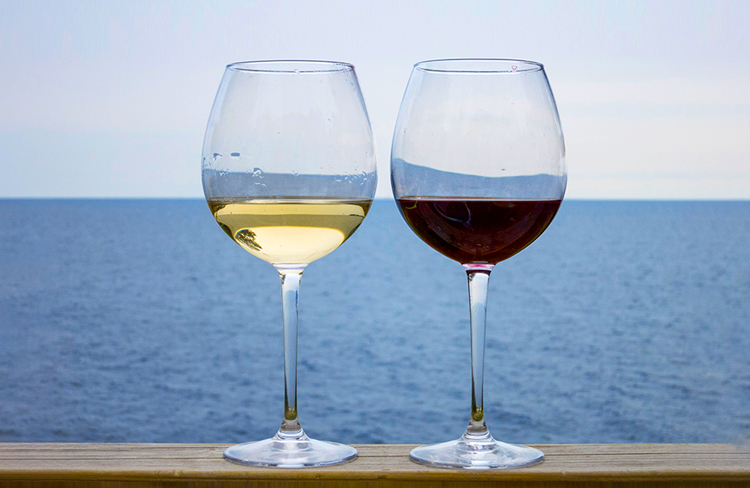
- Depends on location
- Wine
-
Noto Peninsula's climate, weather, nutrient-rich soil and sea breeze contribute to the milder taste and acidity level of the grapes harvested in the area. Aside from the vineyard tours and wine-tasting in the three wineries of Ishikawa, you can also enjoy savory local cuisines paired with your choice of wine (bubbly, fruity, or light, among others) in the winery restaurant.
-
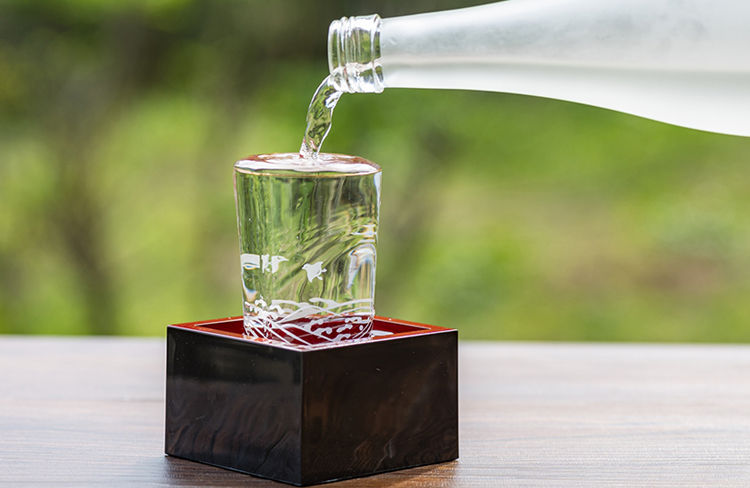
- Depends on location
- Sake (Rice wine)
-
The history of sake-brewing in Ishikawa can be traced back to over 2,000 years ago. Ishikawa is home to one of the best sources of rice and natural water, and the cold winters allow for slow fermentation and create smooth, high-quality brews. Local sake pairs especially well with local Ishikawa cuisine, called Kaga-ryori. Several breweries offer guided tours and tastings.
-
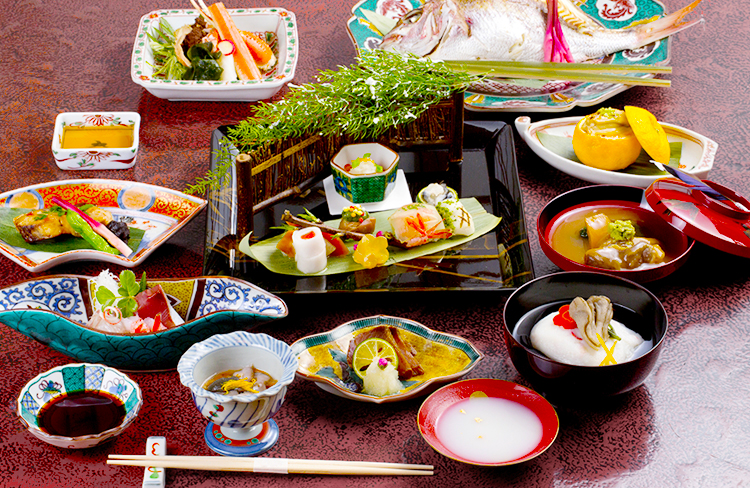
- Depends on location
- Ryotei Restaurant
-
A ryotei is a luxurious restaurant serving the Japanese haute cuisine kaiseki ryori. This consists of a series of small dishes of local ingredients immaculately prepared and presented to reflect the seasons, creating the perfect fusion between cuisine and artistic expression. The historic city of Kanazawa boasts a large concentration of ryotei that carry on the traditions and culture of the region to this day, including its cuisine, architecture, gardens, furnishings, and art.
-
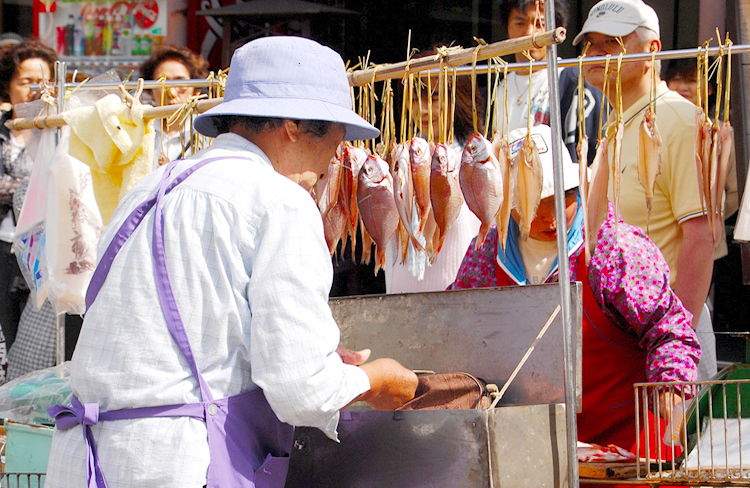
- 108km
- 100mins
- Wajima Morning Market
-
With over 200 stalls, Wajima Morning Market is one of the three biggest morning markets in Japan. Its history dates back over 1,000 years when locals would barter for fish and vegetables during shrine festivals. The energy of the vendors hawking freshly caught fish, local fruit and vegetables, and various dried goods draws curious visitors from all over the country. Some stalls sell locally-made crafts, textiles, and snacks such as sweet bean-filled rice cakes. Free grilling stations let shoppers cook their purchases to eat them on the spot.
-
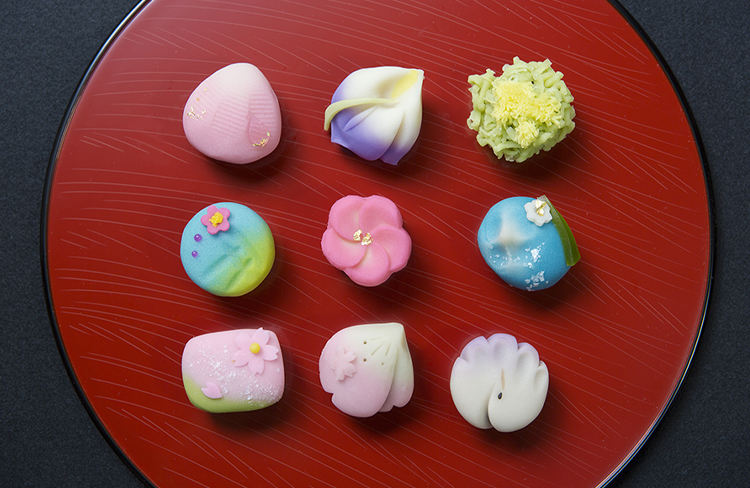
- Depends on location
- Japanese Confectionery
-
Kanazawa, Kyoto, and Matsue are called the three greatest Japanese cities for making confectionery. With the Maeda Clan*3 actively promoting tea ceremony during the Edo Period (1603-1867), Japanese confectionery has developed to become an indispensable part of the tea ceremony. Japanese sweets are made with advanced techniques in images of seasonal decoration, hand crafted from raw ingredients, such as rice, red beans, and sugar.
Nature
Shiroyone Senmaida Rice Terraces
- 118km
- 110mins
- From Kanazawa Port
Zig-zagging, hillside vivid green rice paddies contrasting with the blue sea form a view that draws photographers from around the world. There are more than a thousand rice paddies built on steep slopes, with narrow and irregular shapes that make farming difficult for machines. As a result, local farmers and volunteers plant and harvest the rice by hand. This traditional way of cultivating rice has been designated by the United Nations as Globally Important Agricultural Heritage Systems (GIAHS) site in 2011.
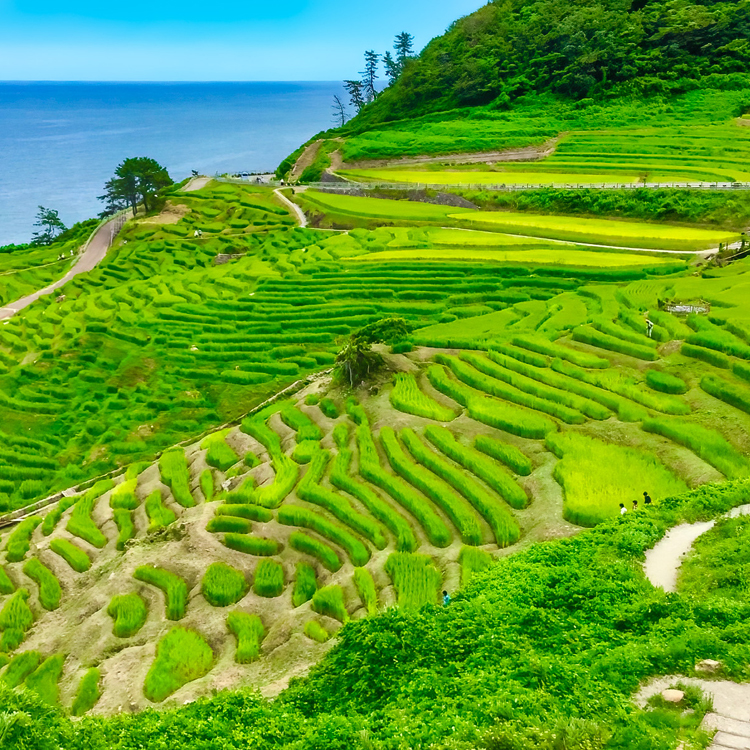
-
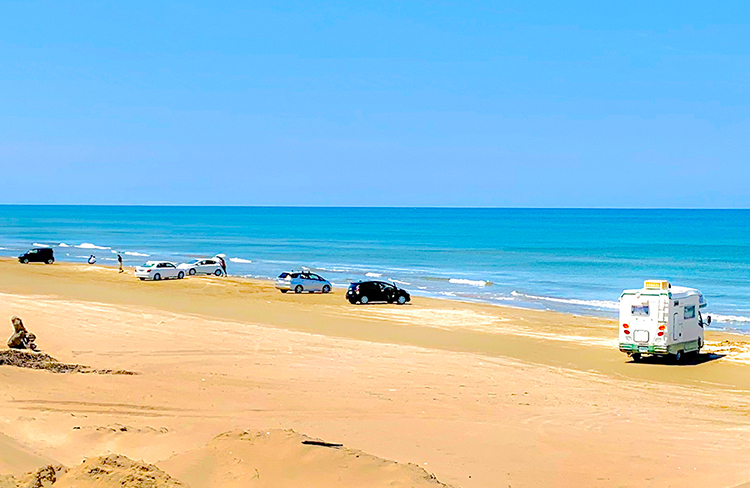
- 31km
- 30mins
- Chirihama Nagisa Driveway
-
Drive your car on the beach!
Found on the western coast of Noto Peninsula, the Chirihama Nagisa Driveway is the only sandy beach in Japan that is open to cars. Traffic runs in both directions on the 8-kilometer stretch alongside the Sea of Japan, made possible by the unique sand. Visitors are free to park their cars out of traffic and wade in the water or search for seashells. Food stalls that are open from spring through fall at the southern end of the drive sell grilled shellfish such as oysters and other local delicacies.
-
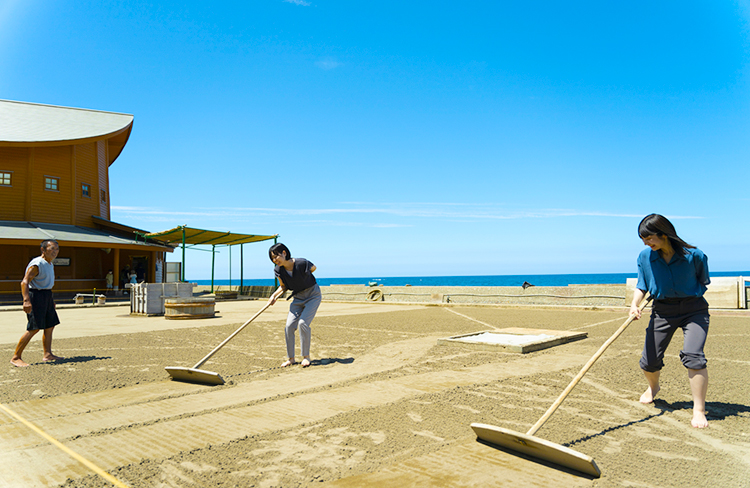
- 130km
- 120mins
- Suzu Salt Farm Village
-
The people of the Noto Peninsula have been harvesting salt from seawater using the same traditional methods for about 500 years. Suzu Salt Farm Village, the only facility in Japan that uses the traditional technique of harvesting salt called agehama, offers an in-depth experience where visitors can learn about and observe salt production. Watch the salt-gathering process on sunny days between July and mid-October, or participate in a workshop and take home the salt you produce at this museum/roadside station.
-
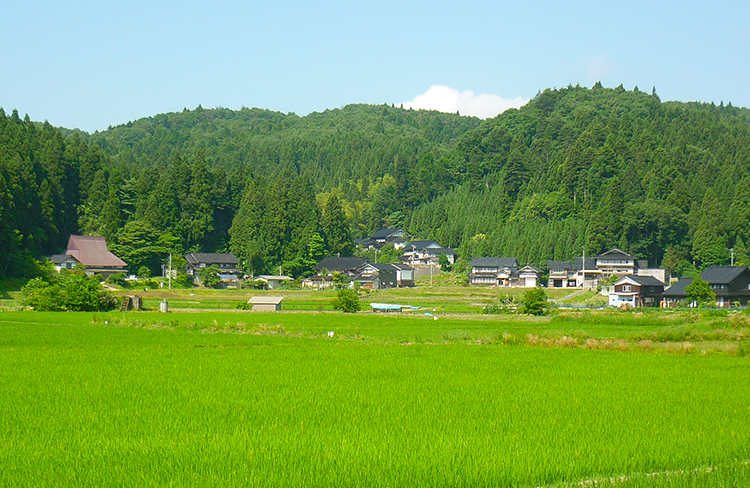
- 105km
- 100mins
- Shunran-no-Sato
(Farmhouse Inns) -
Enjoy the traditional sustainable way of life in Shunran-no-Sato, a community of 47 authentic farmhouses in Noto Peninsula that serve as inns for travelers. The houses have sunken fireplaces (irori) around which guests can enjoy local cuisine served in vermillion-lacquered Wajima-nuri. Guests can enjoy activities such as foraging for wild vegetables and mushrooms, harvesting and planting rice, fishing in mountain streams, cycling, stargazing, tea ceremony, and Zen meditation. All farmhouses follow the policy of welcoming only one group of guests per house.
-
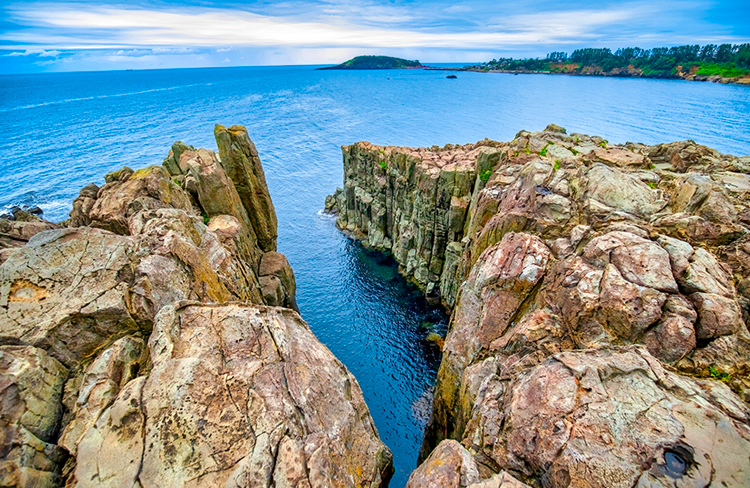
- 75km
- 75mins
- Tojinbo Cliffs
-
Tojinbo Cliffs are a 1-km stretch of rocky coastline on the Sea of Japan, found just north of Fukui City in Fukui Prefecture. The coarse, pillar-shaped hexagonal rock formations have been carved out by the crashing waves, leaving deep chasms and 30-meter tall cliffs. Explore the trails leading to the edges of the cliffs, or take a short cruise and appreciate the impressive sight from below. There is also an observation tower and commercial area with shops and restaurants for visitors.
-
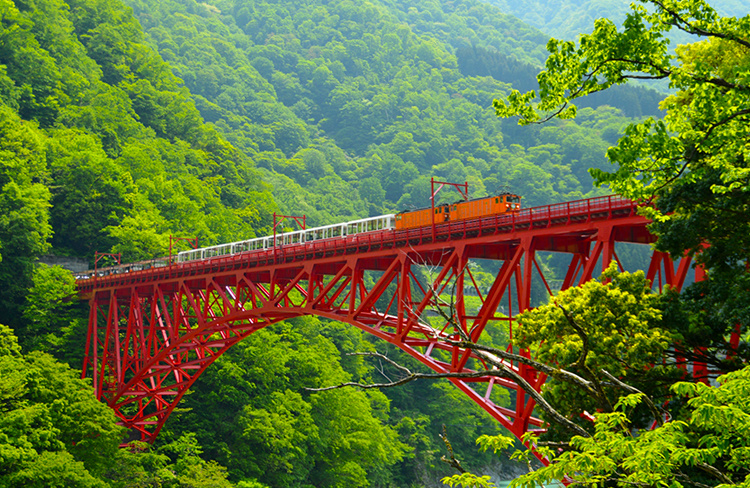
- 96km
- 90mins
- Tateyama Kurobe Alpine Route
-
Tateyama Kurobe Alpine Route passes through the dynamic scenery of Mt. Tateyama in the Japan Alps. It is traversed using a variety of vehicles with an elevation change of 2400 meters. The route is approximately 90km long and you will be impressed by the variety of scenery you will see throughout the seasons. A 500m-long snow wall is formed each spring after snow is cleared for the opening of the Alpine Route. The snow wall can reach up to 20m high, allowing visitors to walk between the walls like a canyon made of snow.
-
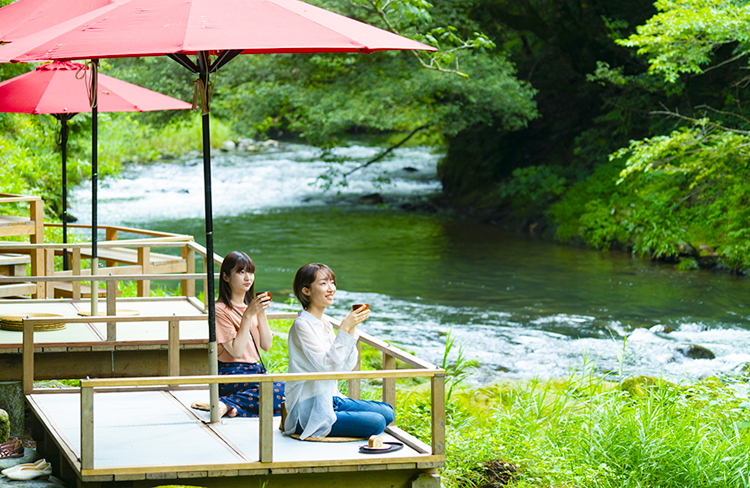
- 57km
- 60mins
- Kakusenkei Gorge
-
The 1.3km Kakusenkei Gorge is a stretch of the Daishoji River that runs through lush forest near the quaint hot-spring village of Yamanaka Onsen. Its unique bridges are the imposing, arched Kurotani (Black Valley) Bridge made of stone, the 94.7m S-shaped, wine-red, trestled Ayatori (Cat's Cradle) Bridge designed by avant-garde filmmaker Hiroshi Teshigahara, and the elegant Korogi (Cricket) Bridge built entirely of cypress. Spend a relaxing time at Kakusenkei Kawadoko riverbed by listening to the soothing sounds of the water while savoring delicious Japanese sweets designed by Iron Chef Rokusaburo Michiba.
-
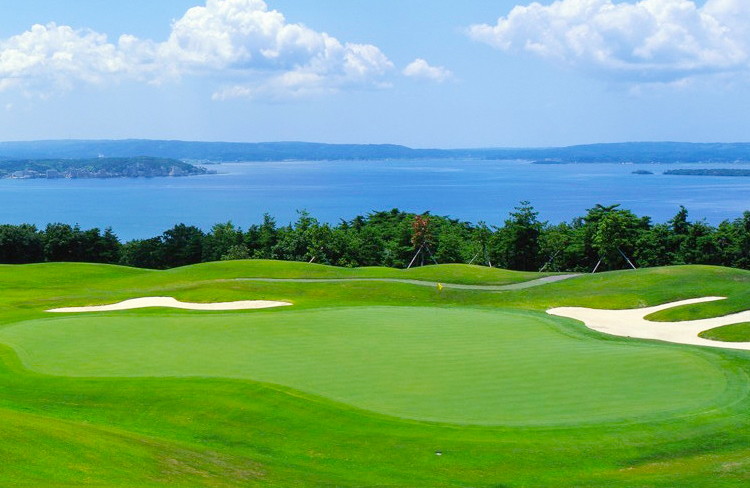
- Depends on location
- Golf in Ishikawa
-
Ishikawa has more than 20 golf courses which can not be rivaled elsewhere in their magnificent beauty. Course layouts and maintenance are some of the best in the country. The closest golf course to the port is only a two minute ride from Ohama Wharf. If golf is your passion, Ishikawa is waiting for you!
-
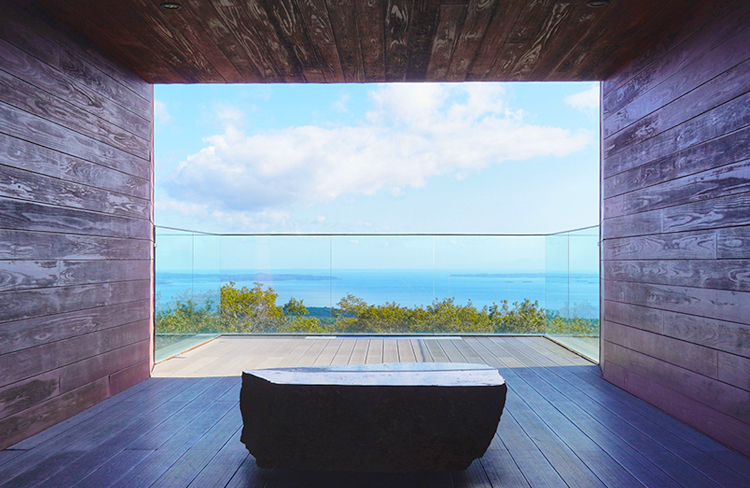
- 78km
- 70mins
- Nanao Bay & Notojima Cycling
-
Rental bicycles are an enjoyable, active way to sightsee around Nanao Bay. The cycling course is about 40 kilometers in total. The route passes through idyllic natural scenery and landmarks such as the Notojima Bridge, the longest bridge in Ishikawa. It is also a convenient way to get around Notojima Island, a picturesque agricultural community off the coast of the Noto Peninsula. Cycle around and see the landscape while experiencing rural Japanese life.
-
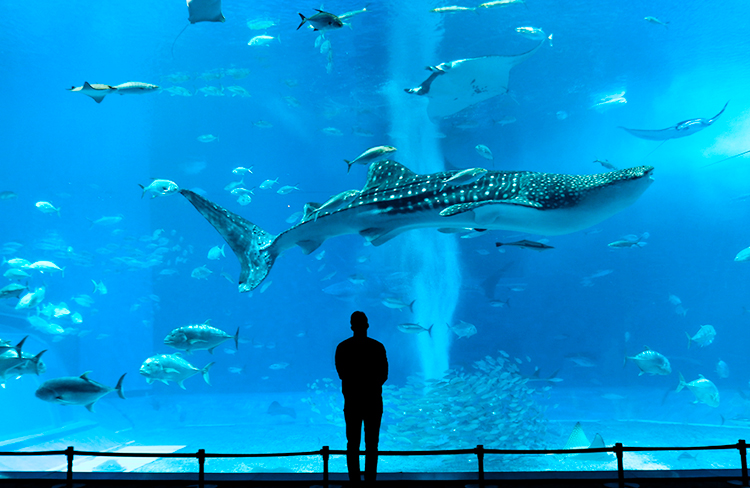
- 83km
- 80mins
- Notojima Aquarium
-
With approximately 500 species, Notojima Aquarium specializes in marine life from the waters off the Noto Peninsula. Aside from watching penguins and dolphins swim from a tunnel beneath the tank in the popular areas of Whale Shark Zone and Dolphin Zone, try your hand at feeding and touching other kinds of fish. Projection mapping across parts of the aquarium floor and ceiling lend to an immersive experience for young and old alike.
Onsen Bath Towns
-
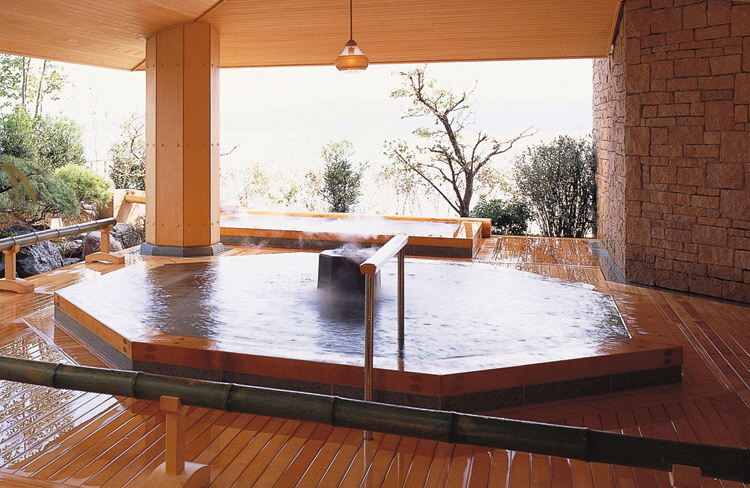
- 71km
- 60mins
- Wakura Onsen
-
Wakura Onsen is an easily accessible hot-spring resort near the base of the Noto Peninsula. Dominated by massive ryokan (Japanese-style inns) complexes along the water's edge, offering a scenic view of the sea. They are equipped with hot spring baths, restaurants, karaoke rooms, bars, and game centers. People have been bathing at Wakura Onsen for 1,200 years. Legend has it the hot springs’ undersea source was discovered when a farmer and his wife noticed a heron trying to repair its injured leg in the warm water. Since then, Wakura Onsen owes some of its popularity to people's wellness.
-
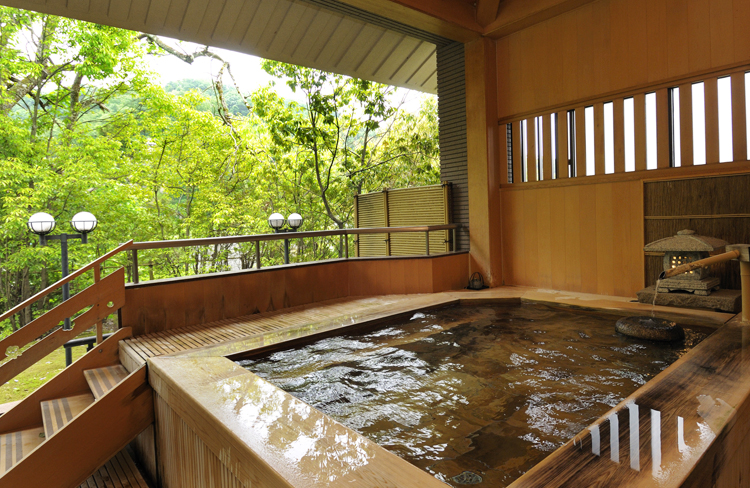
- 26km
- 45mins
- Yuwaku Onsen
-
Located in the southeast of Kanazawa, this mountainous resort is accessible by a 45-minute car ride from Kanazawa Port. It was once a popular hunting destination and a hidden hot spring of the Maeda Clan*3. It is a hypotonic, mildly alkaline hot spring with a clear, colorless water quality. Choose from the nine traditional ryokan inns and immerse yourself in the relaxing waters in the peaceful atmosphere of the valley, or visit the nearby Edo Village or museum to learn about history and satoyama.
-
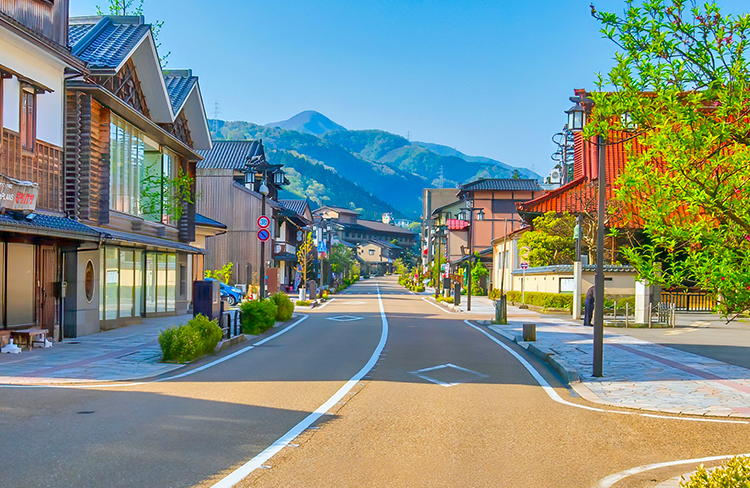
- 57m
- 60mins
- Yamanaka Onsen
-
Located in the mountains of the Kaga area, with a history of more than 1,300 years, the hot-spring town of Yamanaka Onsen boasts a vibrant and beautiful blend of nature and traditional culture. The town’s onsen baths and mountain scenery have fostered a rich culture of song, dance, geisha performing arts, and handcrafted lacquerware. From Kiku-no-Yu bathhouse, walk along Yuge-kaido main street to catch a glimpse of numerous shops and galleries featuring Yamanaka lacquerware and Kutaniyaki porcelain.
-
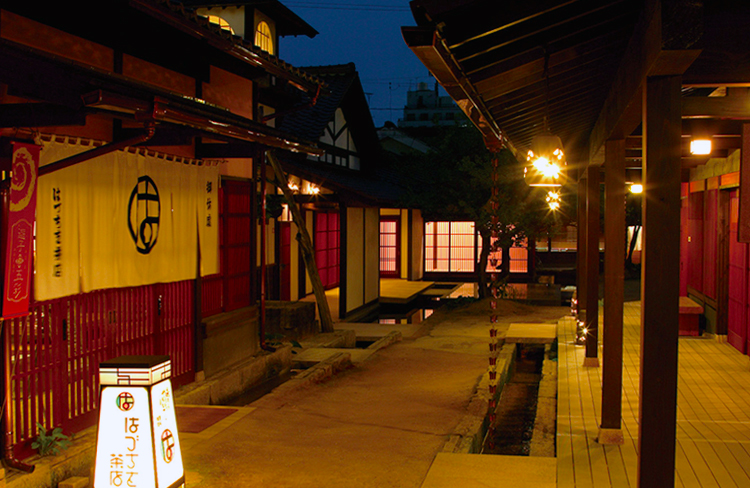
- 52km
- 60mins
- Yamashiro Onsen
-
Yamashiro Onsen is a traditional hot-spring resort town nestled in the foothills of Mt. Hakusan*1. It is one of the four hot-spring towns of the Kaga Onsen area, first discovered over 1,300 years ago. Yamashiro Onsen is home to several lavish hotels and ryokan inns, but also has more diverse price ranges. Most offer day-bathing options to visitors who are not staying overnight. The Soyu public baths offer all the trimmings of a modern hot spring; however, the Ko-Soyu bathhouse, recreates the older traditional architecture and bathhouse culture where visitors pour bathwater on themselves (due to absence of showers) before taking a dip.
-
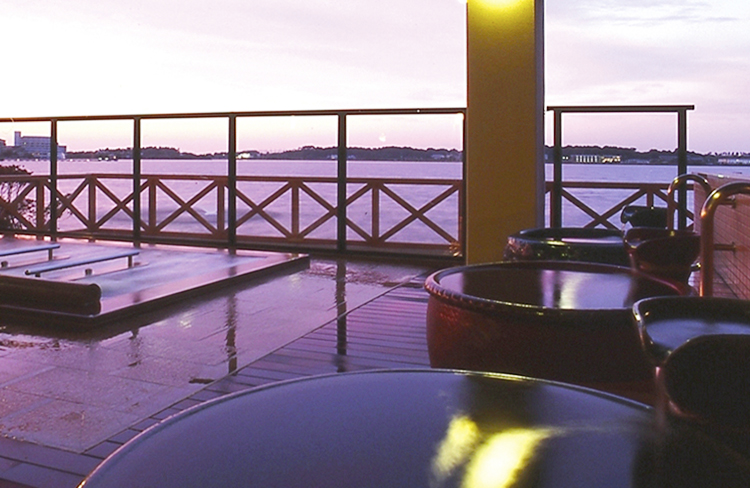
- 43km
- 45mins
- Katayamazu Onsen
-
This lakeside hot-spring town on the shore of Lake Shibayama has the most beautiful view of Mt. Hakusan*1. The lake-bed is the source of the naturally rejuvenating waters filling the town’s baths. Katayamazu Onsen has several hot-spring inns and ryokan at varying prices. The public Katayamazu Soyu bathhouse's contemporary facility was designed by architect Taniguchi Yoshio, who also redesigned New York’s Museum of Modern Art.
-
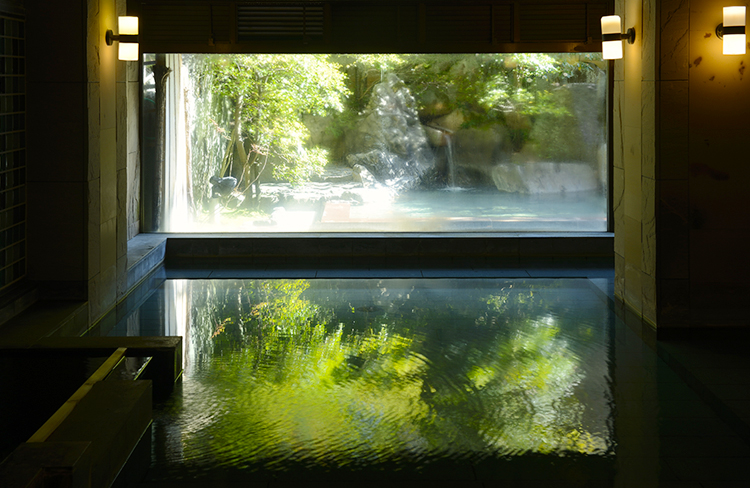
- 41km
- 50mins
- Awazu Onsen
-
Awazu Onsen is one of the hot-spring towns that make up Kaga Onsen. According to legend, its waters were discovered over 1,300 years ago by the same Buddhist monk who founded Natadera Temple. The clear spring waters are rich in sodium sulfate, suitable for drinking and has been popular since ancient times for its healing properties. The town’s historic ryokan accommodations include one of the world’s oldest hotels and longest continuously operating companies, as verified by the Guinness World Records.
Festivals & Seasonal Interests
-
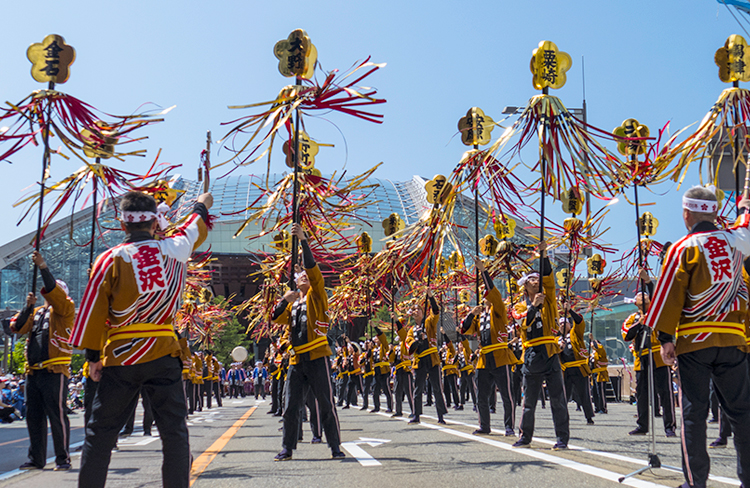
- Hyakumangoku Festival
(June) -
To commemorate the historic entrance of Maeda Toshiie (1537-1599), the first lord of the Kaga Domain*2, into Kanazawa Castle on June 14, 1583, the Hyakumangoku Festival is celebrated with taiko drumming, Noh performances, lion dances, and a parade of actors in Edo-period costumes recreating that momentous occasion in history. The Hyakumangoku Festival is held on the first weekend of June and is the largest festival in Kanazawa.
- Hyakumangoku Festival
-
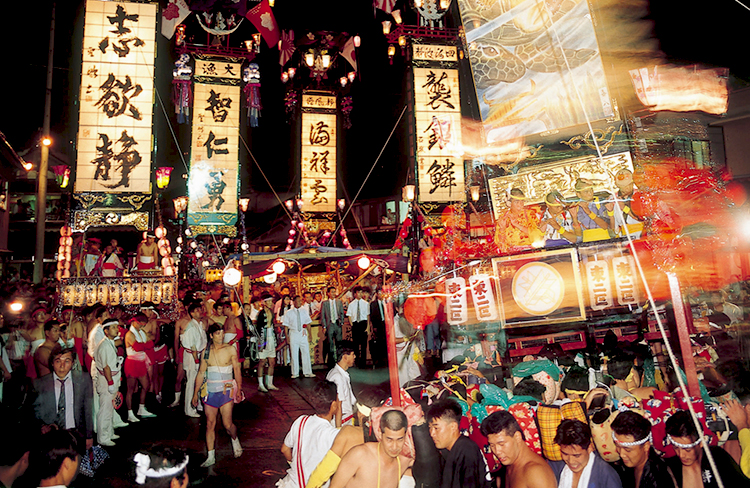
- Festivals in Noto Peninsula
-
Noto hosts Ishikawa’s most lively festivals. In spring, the thousand-year-old Seihakusai Festival steamrolls through the town of Nanao with three 12-meter-tall floats weighing 20 tons each. Visitors are encouraged to help pull the floats along their route, even as they reach running speed. Between July and September, the Noto Peninsula hosts roughly 200 festivals featuring kiriko—ornate, towering lanterns carried on the shoulders of townspeople. The specific events of each kiriko festival vary, but they are all passionate expressions of the community’s energy and hard work.
-
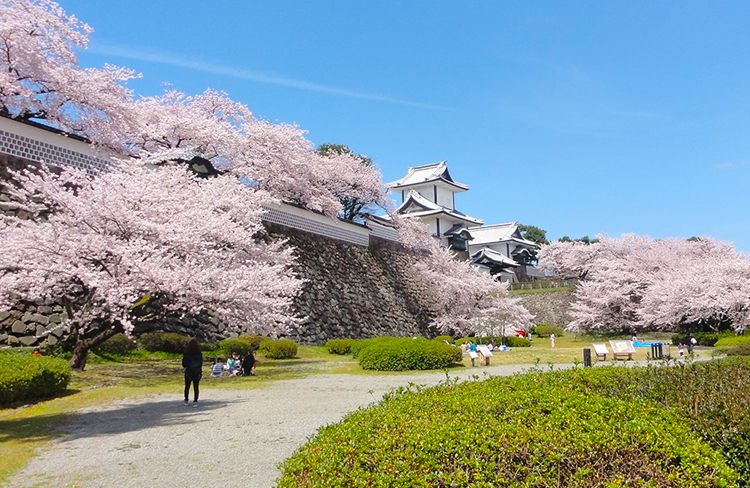
- Spring Blossoms
-
The coming of spring is marked by the blooming of different flowers, but the highlight of the season is the sakura (cherry blossoms). The streets of Kanazawa are wrapped in light pink as fluffy sakura are in full bloom in April. People beam excitedly and go out for hanami (flower-viewing) to welcome the spring. During the peak bloom period of sakura, Kenrokuen Garden is open to public for about ten days (free of charge).
-
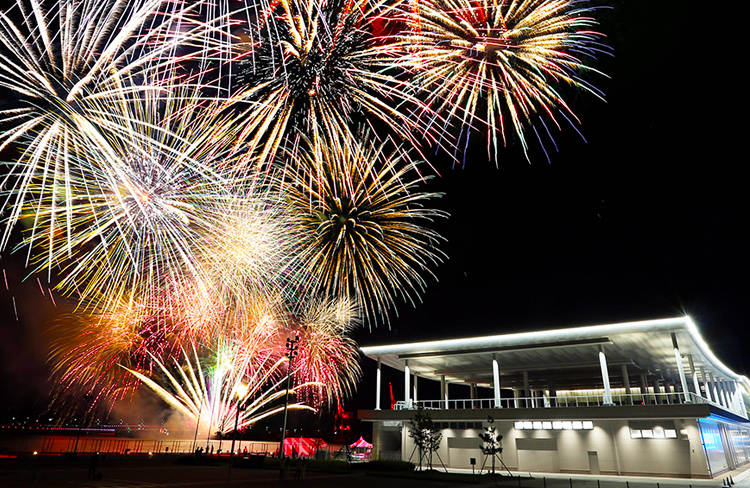
- Summer Fireworks
-
The summer season is marked most notably by the art of fireworks in Ishikawa. Each region holds events, drawing large crowds to see the beautiful colors and shapes of the fireworks. Pyrotechnic specialists come from far and wide to show off their best demonstrations each year.
*Confirm the dates and times as they change yearly.
-
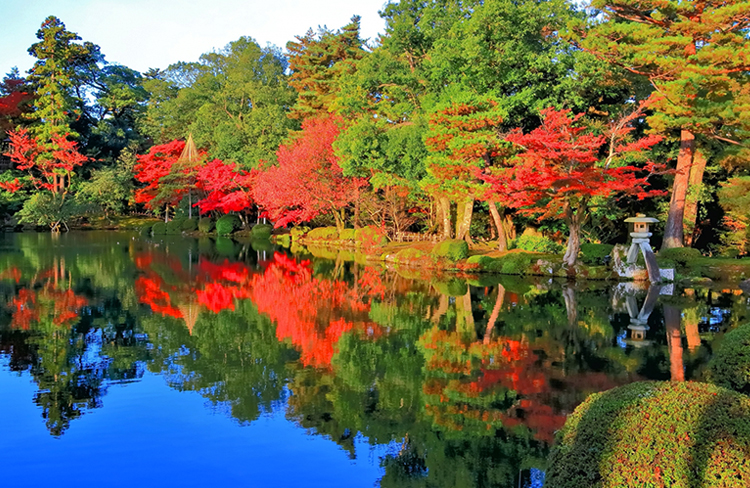
- Autumn Foliage
-
Late October is the best time to begin seeing red foliage in Kanazawa, but the vibrant colors of the autumn leaves are at their peak in mid-November in Kenrokuen Garden. Breathe in the brisk air in the evening as you feast your eyes on the enchanting atmosphere created by the artfully lit up red and yellow leaves on branches supported with yukitsuri ropes.
-
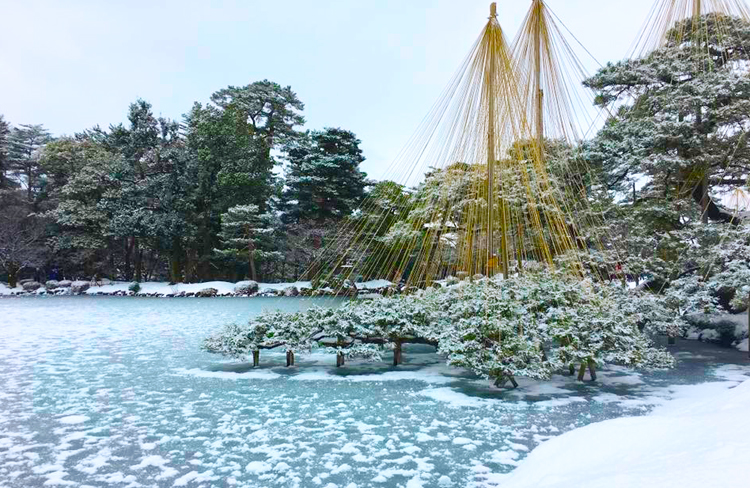
- Winter Attractions
-
Due to Kanazawa's heavy and damp snow all winter long, tent-like rope supports called yukitsuri (lit. "snow hanging") are installed on November 1 to prevent the delicate branches of the trees in Kenrokuen Garden from breaking due to the weight of the snow. See the magical beauty of the garden at night, when the glassy, frozen ponds reflect the illuminated pine trees, creating a magical atmosphere.
Accommodations
-
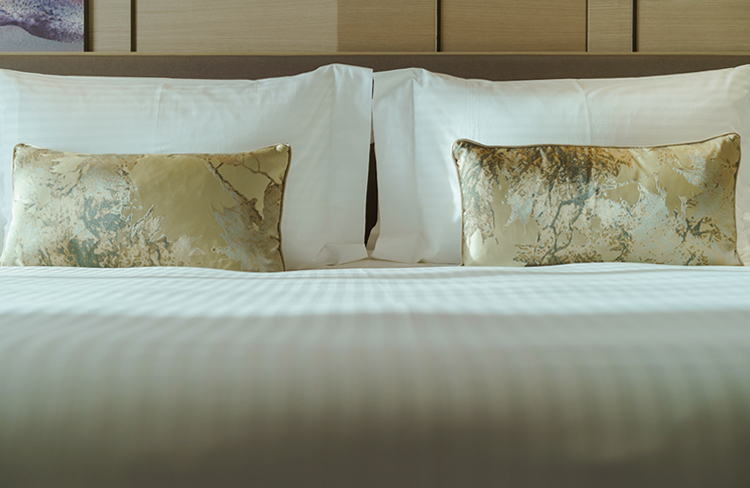
- Hotels
-
Hotels are plentiful around Ishikawa. They are suited to a range of budgets, and nearly all offer western-style bedrooms and facilities. Most have English-speaking staff and a choice of smoking or non-smoking rooms. Some hotels may have Japanese-style baths on premises. In 2020, Hyatt Centric Kanazawa opened near JR Kanazawa Station offering even greater accommodation options for travelers.
-
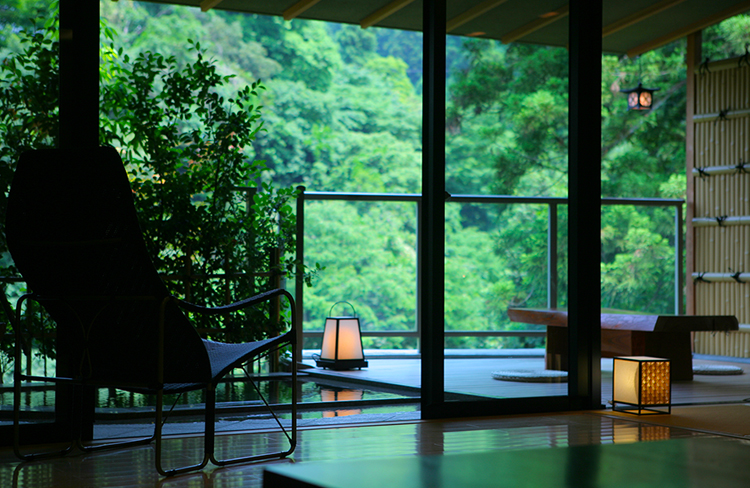
- Ryokan (Japanese-style Inns)
-
Ryokan are traditional-style inns, where guest rooms have tatami straw floors upon which futon mattresses are laid out for sleeping (although some also offer western-style beds). The cost of a night usually includes a multi-course kaiseki dinner and breakfast, which are sometimes served in the guest’s room. Most ryokan lodgings have communal hot-spring baths, while some have private baths available in their rooms.
-
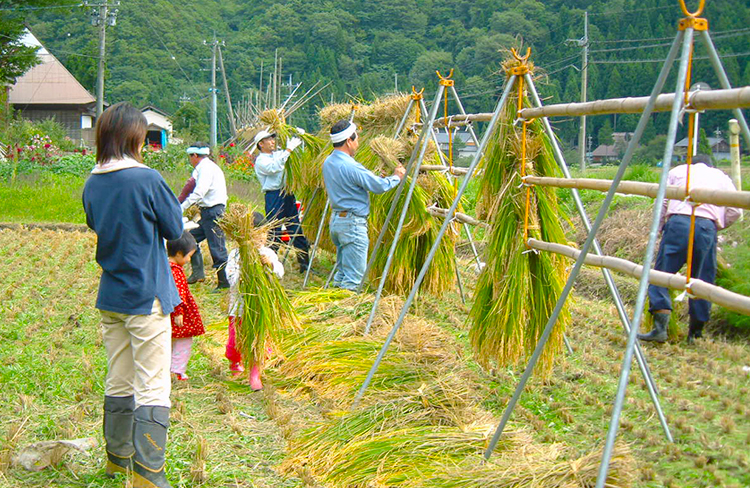
- Unique Accommodations
-
At farmhouse inns, guests can experience Ishikawa's agricultural traditions and slow-paced lifestyle, participate in activities such as berry-picking or rice-planting. Some Buddhist temples offer stays called shukubo. Most temple lodgings are simple, serve traditional vegetarian meals, and offer an opportunity to join meditation and morning rituals.
Nightlife
-
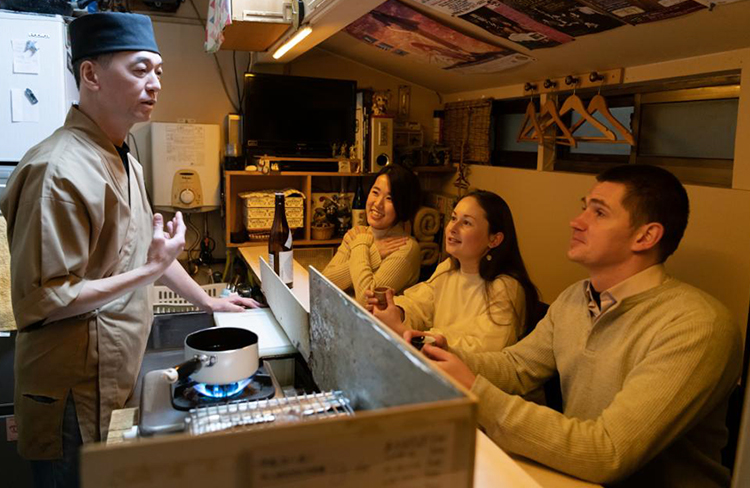
- Restaurant and Bar-Hopping
-
There are a multitude of restaurants, sushi shops and bars lining the streets of Shintenchi shopping street, Katamachi area and Kanazawa Station's surrounding areas. Fish caught the same morning and vegetables of the Kaga area are prime examples of Kanazawa's bright food culture. Why not hit the town like the locals do and enjoy great food if you are spending the night or having a late departure? You won't be disappointed.
-
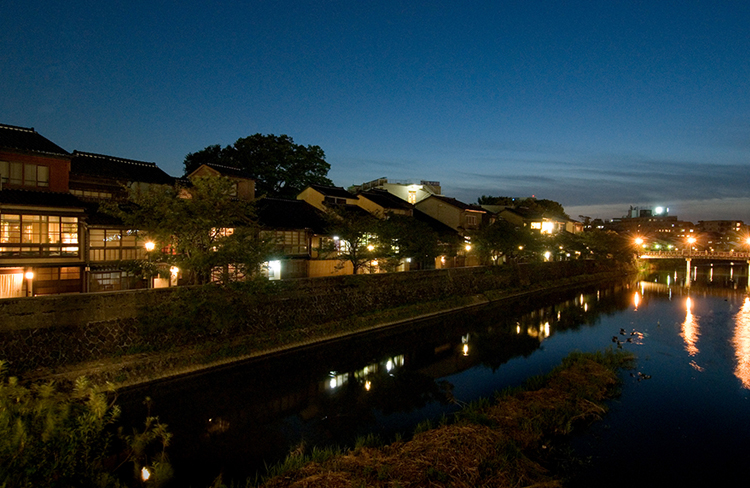
- Illumination
-
Kanazawa is blessed with many ancient style townscapes still preserved like they once were. Illumination of many buildings, such as Kanazawa Station, the 21st Century Museum and Kanazawa Castle glow in the night, giving the city an otherworldly appearance visitors enjoy. Seeing the city by night will reveal many wonders, so why not head out for a stroll through the winding streets of the city?
*Confirm light-up times and duration before your visit.
-
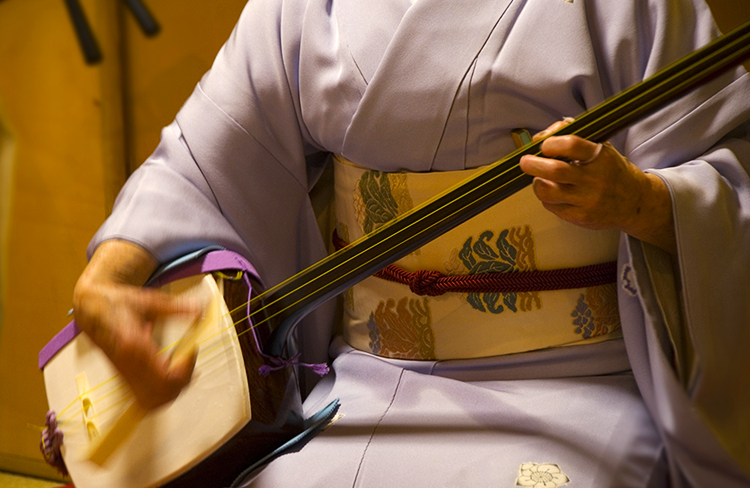
- Kanazawa Geigi (Geisha)
-
Geisha in Kanazawa, locally called geigi, value their customs and ceremonies that have been handed down from generation to generation since the feudal era. Refined dance performances and the playing of various musical instruments (such as shamisen three-stringed guitar and taiko drums) have also been passed down. You can enjoy geisha performances to the fullest in the Higashi, Nishi and Kazue-machi Chaya Districts, where pristine wooden teahouses with their lattice windows have been well-preserved.
Special Experiences
-
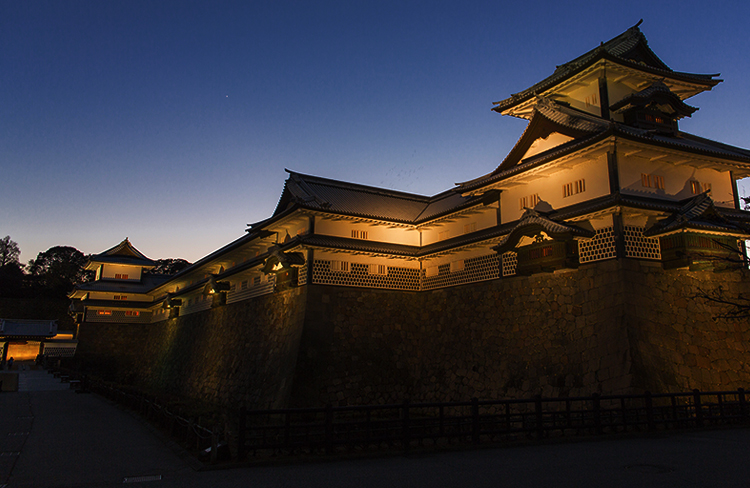
- Private Banquet in Kanazawa Castle
-
The long side wing of Kanazawa Castle, known as Gojikken Nagaya, can be reserved for indoor or outdoor private parties and events. Aside from Noh and Kyogen drama actors, traditional geisha (locally called geigi) dancers, can be hired to bring the culture and art of Kanazawa to any special event.
-
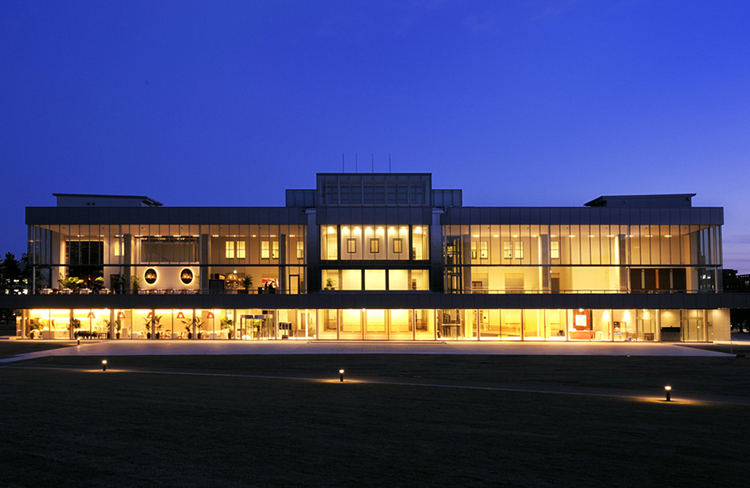
- Private Party in Shiinoki Cultural Complex
-
The three-star Michelin restaurant, Paul Bocuse, is housed across from the Kanazawa Castle Park in the Shiinoki Cultural Complex. At the restaurant you can dine on incredible food while enjoying the castle lightup in a panoramic view from the building. The entire restaurant can also be rented for your special event or occasion.
-
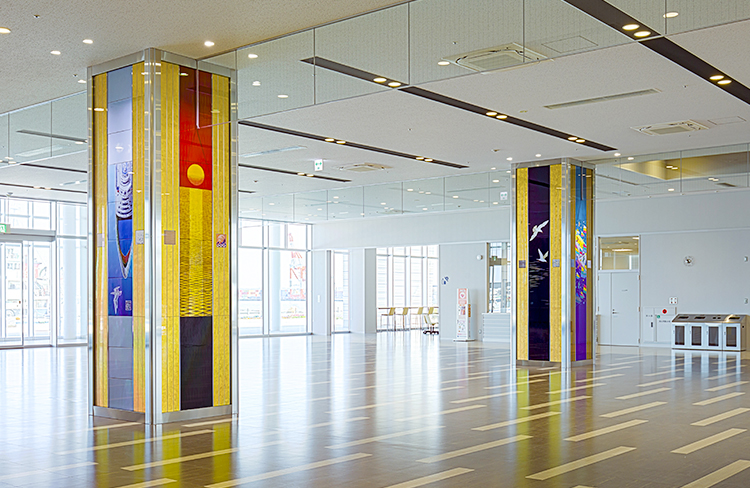
- More Hidden Gems
-
We have much more information available through our offices. Please feel free to contact us at any time. We will do our best to help you experience Ishikawa by tailoring a plan to meet your needs.
- Mt.Hakuran
- considered one of Japan's three sacred mountains along with Mt. Fuji and Mt. Tateyama. This 2,702-meter mountain has been a destination for ascetic worship since ancient times.
- Kaga Domain
- territory corresponding roughly to present-day Ishikawa Prefecture and surrounding areas, whose capital was centered on Kanazawa Castle.
- Maeda Clan
- feudal lords who founded and ruled Kaga Domain from 1583 to 1869.
